- Work For Us

5 steps to writing a ‘First 90 days in the job’ presentation
Written by Iain Flinn
Helping business leaders in the enterprise software, Cloud/SaaS/PaaS and emerging technology sectors to identify talent and build high performing teams across EMEA.
Table of Contents
Writing a ‘First 90 days in the job’ presentation doesn’t have to be daunting, follow our guide and create a presentation that gets you the job of your dreams.
Are you preparing for the final stage of an interview for your dream job? Don’t let the thought of creating a ‘First 90 days in the job’ presentation overwhelm you. This presentation is your opportunity to showcase your skills, demonstrate your understanding of the business, and impress your potential employer. In this guide, we’ll show you how to create a presentation that stands out from the crowd .
Like a honeymoon, only you’re much easier to ditch
The first 90 days of a new role is a grace period, You’re getting to know the people, the business and the culture. But this crucial first 90 days on the job is also the time that lasting impressions are made. Remember, you’re a risk to the business and your employer will be using this period to establish whether they made the right decision. That’s why the ‘first 90 days in the job’ presentation is as much for you, as it is for your future employer. You stand to gain a lot from laying down the foundations for the first three months.
That’s why it’s important, here’s how to write one:
Start researching in your first interview.
If you’re already past this stage, it’s fine, just try to recall the information and don’t be afraid to revisit conversations if necessary. You need to know all about the business needs and ambitions, so ask questions, probe for answers and listen. Then build your presentation around their key objectives and goals. Good questions to ask:
- What’s your mission statement and vision?
- What is the company trying to achieve?
- What are you (the hiring manager) trying to achieve?
- What challenges does the department face?
- What do you expect from me?
- What critical projects are you managing at the moment?
You’re looking for multiple ways to help them. Have this in your mind throughout your interviews, it’ll put you in a great head-space to be inquisitive and retain control.
Focus on your potential employer’s needs
This is why you need to do the above research. Your presentation isn’t just about you, it’s about your employer , so you’ll need to understand their needs and place them at the centre of your presentation. Get a full understanding of the objectives of the role, the goals of the hiring manager and the department as a whole. Then, demonstrate how your experience and knowledge can support these objectives.
Add your strengths, carefully
Shouting about your skills in a vacuum will get you nowhere, but align them to the goals of your potential employer and they will start to see the real tangible value of your experience . Think feature and benefit, not just feature. For example: Feature: “I’ve delivered £multi-million field marketing campaigns”. Feature and benefit: “I’ve built and delivered £multi-million field marketing strategies for my current employer, so in the first three months I’d review the company’s strategy for the roll-out of similar campaigns. Using my industry knowledge, I’ll ensure we’re using the right channels, to target the right audience with the most impactful messages. Furthermore, with my experience of using an array of marketing automation platforms, I’ll ensure we’re using the right systems and tools to correctly measure the impact of our strategy and the overall ROI. At my previous employer, in my last marketing campaign, I was able to deliver this under budget by £18,000, whilst generating a 156% increase in leads for our sales team which resulted in a 71% year-on-year increase in sales.” Use proven and tangible real-world examples to align your skill set to their objectives. Ensure your examples showcase your skills and experience, but make sure your pitch is in line with their goals.
Say what you’re going to do, day-to-day
Explain to the hiring manager how you’ll fill your days. This will vary depending on your role, but use the actions below as a foundation for more specific contributions:
- You’ll get immersed in the department and brainstorm how your input can increase company growth.
- Having gotten a better understanding of the business, you’ll start advising, leading and contributing to the conversation.
- See more of your colleagues’ desks than your own. Get out amongst the team and get to know them by name, their role, ambitions, challenges and more.
- Go above and beyond by taking on some tasks outside of your remit. Remember – you’re there to help.
- Behind all of this sits one unshakable focus – your boss’s expectations of you. You’re always aware of them, and what actions and decisions will you take to ensure that you meet them?
- Time-stamp your objectives for the first 90 days, and put a tangible project plan in place to show that you’ve thought it through.
How will you over-deliver?
Giving your employer more than they expect is business as usual, but how will you raise the bar and show them what excellent looks like? Towards the end of the third month, you should be feeling comfortable and confident in the role, so use these foundations and consider discussing how you’ll go ‘above and beyond:
- You’ll be proactive when it comes to relevant company situations and events.
- You’ll be aware of new projects coming on-stream and prepare potential solutions.
- You’ll be getting more involved by joining a club, council, board, or committee.
- You’ll make yourself available to other departments if there’s a need for your skills.
- You’ll take on work outside of your responsibilities to accelerate business growth.
Do all that and you’ll turn from a risk into an asset
Remember, a strong 90-day presentation will reassure your employer that you’re going to make a positive difference in their organisation. It outlines the skills you’ll bring, how they’ll help and the value you’ll add, making it easier for the business to see their potential return on investment. And for you, it provides focus and confidence at a time when an unfamiliar routine (or lack of a routine) can cause added stress. Channel that pressure to impress and use it to create a ‘First 90 days‘ presentation that puts you way ahead of the competition.
Need a talent partner?
Tell us what you are looking for and we will help you build a solution
Like what you’ve read?
Related posts, do you need a fractional talent management leader, how to get an entry-level sales role in saas, stay tuned.
Sign up here to hear about the latest career opportunities, industry news, and thought leadership topics from our fellow Animators.
Interview tips: building a 90-day presentation that’ll get you noticed
Like a number of us, I was affected by the impacts of the coronavirus. But not unlike you, I know this is not the time to panic but an opportunity to refine my interview skills, polish up my resume and continue to push forward in hopes of securing my next role.
When going through the interview process, you will likely have to present on several topics that might include presenting:
- Your GTM plan and strategy
- Your first 90-day plan
- An effective content strategy
- On how to put together a successful win/loss program.
For this article, I will focus on what I believe equates to a successful 90-day plan . Before you get to this point in the interview process, you have likely had several interviews where you gained a better understanding of the role within the company, the opportunity, or challenges that lay ahead and have a better understanding as to where you would focus your time if given the opportunity.
This is where the hard work begins.
This is where you can demonstrate how you would approach your first 90-days in the role.
Think about how you would organize your thoughts and make a strong case for your employment.
You are not only evaluated on your ability to put together a comprehensive and articulate 90-day plan. Your delivery, execution, and overall presentation skills will put under a microscope as well.
The presentation will likely be 15-20 minutes in length. Be prepared to answer questions and be specific in your response. This will show you have prepared and put in the effort to demonstrate exactly how you will react in certain situations.
Remember, everything you do is being evaluated and critiqued. Make sure you make eye contact through the presentation. Prepare your talk track. You don't want to appear as though you are reading from a script.
The first thing I recommend is to create your presentation outline. My recommendation is seven core slides.

Now let's dive a litter deeper.
Within slides three through five above , this is where you can set yourself apart from the competition . Be very specific as to what you will be doing. Again, this detail will prove that you understand the role, the company and that you gleaned enough detail from the interview process to highlight items specifically mentioned as gaps, needs, and critical responsibilities .
For each of the "phases" listed above, break down the slide into four categories: Learning, Personal, Initiative, and Performance goals. Under each category, you will need to demonstrate you understand the position and vital responsibilities required of the role. Remember, your goals will look much different in the "Education" phase than in the "Execution" phase.

Upfront, you will have more learning goals than performance goals. As you progress through your first 90 days, your initiative and performance goals will become more extensive, and your learning goals less prominent.
To summarize, the purpose of this activity from the employers' standpoint is to:
- Evaluate your knowledge of the role
- Evaluate your presentation and delivery skills
- Narrow down the candidate pool from roughly three candidates to the person who will receive the offer.
Creating a 90-day presentation that will land you that job offer is not easy; it takes time and should demonstrate why you are THE person for the role. Keep this in mind, and you will ROCK this exercise.

- Media Guide
- Ambassadors
- Privacy Policy
- Terms of Service
- Help Centre
- PMM Certification
We are aware of a global phishing scam with employees from companies impersonated across email, WhatsApp, and Telegram. We are confident that no PageGroup system has been breached. Find out how to protect yourself and the signs to look out for
The first 90 days: a downloadable template and guide

The first 90 days plan
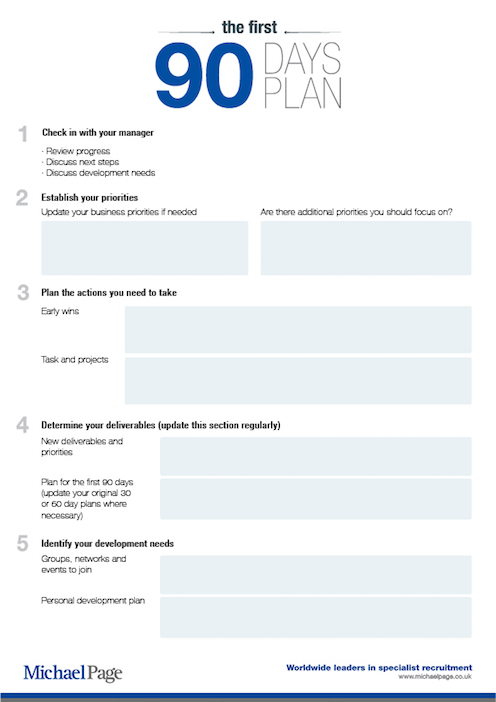
Looking to grow your career this year?
Download our career development toolkit for expert advice.
Try out our job match tool
Take a look through similar roles in your sector to see what else is on offer.
Where next on your professional journey?
Find out what your next career move should be with our quick and easy quiz
Related articles

This website has app functionality. Add it to your home screen for fast access and offline features.
- Harvard Business School →
Read posts from
- Author Alumni
- Author Baker Library
- Author Career & Professional Development
- Author Career Coaches
- Author Professor
Site Section
- Career Coaching
- Connect & Network
- Ongoing Learning
- Transitions & Paths
Content Type
- Alumni Interviews
- Expert Interviews
- HBS Career Journeys
- HBS Working Knowledge
- Industry Resources
- Programs & Events
- Resources & Tips

- 20 Apr 2023
Tackle the First 90 Days of Your Next Role: A 5 Step Process for Success on the Job
Congratulations! After months of networking, interviewing, and sending out resumes, you’ve landed your next role. This is a huge accomplishment!
Celebrate, rest, relax and show your gratitude to the people who helped you achieve this goal.
Then, as day one in your new role draws near, make sure you have everything you need to succeed by following HBS Career Coach Matt Spielman’s five steps to success on the job in the first 90 days.
Why the First 90 Days Matters
In his work educating companies about successful onboarding , Spielman notes the importance of the first 90 days for employees and their employers. “Research suggests that an employee’s first 90 days will in large part determine his or her performance, longevity, and contribution to the company,” he shares.
Therefore, a successful onboarding program designed and executed by the company alongside an intentional plan designed and executed by the employee is critical. This joint process establishes and strengthens relationships, conveys transparency, and ultimately mitigates risk and maximizes success.
“For the employer, key elements of a successful onboarding process include introducing new hires to key stakeholders, setting employees up for success by designing an internal interview guide for conversations, and creating a 90-day plan laid out in three 30-day increments to meet key objectives and goals,” explains Spielman.
The important thing to remember as a new employee – you will not be executing on 90 days’ worth of goals on day one.
“As an employee feeling the pressure that accompanies a hard-won job, you will want to make a positive first impression,” Spielman says. “The natural reaction in many instances is to jump right in but as Jeff Olson said, ‘Sometimes you need to slow down to go fast.’”
Step 1: Detail What, Why, and How
Step 1 in the “slow down to go fast” five-step process is to detail the first 90 days by communicating openly with your manager about:
- What you plan to do to learn your new role and contribute
- Why you are structuring your approach in this way
- How you will execute this plan to make progress
To guide this conversation and keep you focused, break out your first 90 days into a three-segment action plan like the one outlined here . Segments one and two will be dedicated to accelerating your learning and beginning to contribute to the conversation. Segment three (days 61 through 90) will be further detailed as you meet stakeholders and conduct interviews.
Note the importance of quantifying output of each segment and scheduling check ins to manage expectations and maintain open lines of communication.
Step 2: Identify Stakeholders
After laying out your objectives for the first 90 days, the next step is to identify the stakeholders you should meet and interview. The conversations you have as a new employee may be an extension of what you learned during the interview process or provide completely new and highly valuable information.
Identify with your manager who you will be interacting with on a regular basis in your new role and who else within the company you should connect with to gain their insights or to prepare for future collaboration. Then craft your questions for these conversations using the 90-Day Interview Guide.
Sample questions include:
- What is our company’s greatest strength(s)?
- What’s the one thing we’re not doing today to accelerate growth (of revenue, customers, product, service, etc.) but should?
- What would need to happen for the organization to seize the potential of these opportunities?
- What are the biggest challenges the organization is facing (or will face) in the near future?
Step 3: Conduct Interviews
Next, set up your 30-45 minute stakeholder meetings where you’ll have an opportunity to build relationships, learn, and capture important information that will make you successful in your new role.
To make the most of these meetings, determine what method you will use to capture information (i.e. typed or handwritten notes, recorded Zoom meetings, transcriptions) so that you have an organized way to refer back to what you’ve learned and be ready to synthesize in Step 4.
Step 4: Synthesize (and Share?)
Notes in hand, in Step 4 you will be identifying key themes – both from what you did hear and what you didn’t hear in your stakeholder interviews. Were there any inconsistencies you noticed that might require clarification?
From all of the data collected, you will then be able to conduct a SWOT analysis for the company, specifically related to how that will impact the imperatives for your new role.
What you share and when will be up to your discretion. Unless you have significant concerns about the finding, best practice has been to share an anonymized summary of your interviews. “You can provide almost instant value – and make a positive first impression - by offering the insights gleaned during the onboarding process. The company can benefit from your fresh eyes and new perspective.”
Step 5: Build, Share, Work the Plan
Lastly, informed by your job description, job interviews, experiences, and data from the five-step process, you can write out clear goals.
What four goals (approximately) should you plan to achieve and in what time horizon?
To ensure that you are setting the right goals in this process, follow the ACHIEVE model: Action-Oriented, Consequential, Hard not Herculean, Integrated, Explicit, Visualized, and Endpoint-focused. Understanding the meaning and the consequence – the why – behind a goal dramatically increases the chances of it being achieved. Spielman, who designed the ACHIEVE model, states “When we add in the “V,” for the visual representation of the goal, we tap into the power of visualization that athletes have been using for decades.”
Furthermore, when sharing your goals, make sure they are supported by defined action items to will work in service of those goals, as well as a clear articulation as to why these goals are important. Incorporating these elements, along with a deadline for each aim, will turn your list of goals into a clear action plan that you can communicate to others and begin executing on in service of your new company.
More Resources
For more on navigating the first ninety days, check out the resources below:
- Inflection Points: How to Work and Live with Purpose
- “All Aboard!” Five Steps to Ensure New Employees Soar
- The First 90 Days: Proven Strategies for Getting Up to Speed Faster and Smarter
You Might Want to Read
- Revolutionizing Wellness: Kate Twist (MBA 2008) Shapes the Future of Consumer Health Brands
- Finding Alignment to Make Impact: Layla Ramirez (MBA 2017)
- Access real-world employment data from HBS alumni with the Career Trends tool
Go to Job Postings
Search jobs, upload your resume, sign-up for programming and update your post-HBS career information.
PROGRAMS & WEBINARS
View & register for our upcoming career webinars and programs.
See all programs & webinars
The 30-60-90 Day Plan: Your Secret Weapon for New Job Success

When you’re starting a new job, sometimes deciding whether to pack a lunch the first day is a struggle—forget about planning out the next few months. So if you’ve been asked to make a 30-60-90 day plan for your new job—or even earlier during the interview process—you might have a few questions like What? And How? And Do I really need a job or can I live off the grid in a cozy little cave?
But we promise, making a 30-60-90 day plan is possible and it can help you set yourself up for success at your new gig. We’ve got detailed instructions on when and how to make a 30-60-90 day plan, plus a template to guide you and an example to inspire you.
What is a 30-60-90 day plan?
A 30-60-90 day plan is what it sounds like: a document that articulates your intentions for the first 30, 60, and 90 days of a new job. It lists your high-level priorities and actionable goals, as well as the metrics you’ll use to measure success in those first three months. Done well, it will help you make a positive first impression on your new employer—or the hiring manager you hope will be your future boss.
Download The Muse’s 30-60-90 day plan template here .
When to make a 30-60-90 day plan
Many 30-60-90 day plans follow a similar structure, but the level of detail may vary depending on your situation. There are two main times when you might make one: preparing for an interview or starting a new job.
Note: If you’re a manager who wants to make an onboarding plan to help your new hires hit the ground running (without constantly having to ask you what they should do next), you should consider using our self-onboarding tool , a template for outlining your month-one goals for a new hire, as well as creating a week-by-week plan with a thorough list of meetings, readings, and tasks they should tackle in their first month on the job.
For an interview
If you’ve made it to a late-stage job interview, you may be asked something along the lines of, “What would your first 30, 60, or 90 days look like in this role?” It’s a good idea to prepare to answer this regardless of what level role you’re interviewing for, but it’s more common for higher-level positions.
With interview questions like this, the hiring manager is likely trying to understand your thought process going into the job more than anything. They want to know: Do you understand the role and what it would require of you? Can you get up to speed quickly and start contributing early on? Do your ideas show that you’re the right candidate to fill this particular position?
Even if you’re not explicitly asked this interview question, coming prepared with a plan can help you wow the hiring manager and stand out among other applicants. “Employers are looking for people who are agile and proactive,” says leadership consultant Michael Watkins, author of The First 90 Days: Proven Strategies for Getting Up to Speed Faster and Smarter . “By talking about how you would approach your first 90 days, you demonstrate agility and proactiveness.”
In other cases—more commonly for higher-level management or executive roles—you may be asked to do an interview presentation . Creating a 30-60-90 day plan to present is a great way to show the hiring manager that you understand the challenges a company or department is facing and you have a clear plan for tackling them.
Be sure to include a few specific ideas in your interview presentation—depending on the role you’re interviewing for, that could be suggestions for ways to cut costs, increase sales, or improve customer satisfaction. You want to convey: “I’ve got five good ideas, and when you hire me, I’ve got 50 more,” says career coach Eliot Kaplan , who spent 18 years as Vice President of Talent Acquisition at Hearst Magazines.
For a new job
If you’re starting a new job, your new manager may explicitly ask for a 30-60-90 day plan in writing, or you may want to create one for yourself to help ease the transition to your new role. In either case, the goal is to set yourself up to hit the ground running—and to be sure you’re running in the right direction.
“If you come in without a game plan and try to tackle everything, you’re going to get nothing done,” Kaplan says. “Come up with a couple things you can accomplish successfully.”
If you’ve already started the position, you’ll have access to internal resources and your new coworkers, which will make it easier to create a detailed, realistic plan. If there are things you’re unsure about—like goals, expectations, or typical benchmarks—ask! You’ll likely impress your new colleagues with how proactive you are, but more importantly, you’ll gather the information you need to be successful.
Elements of a 30-60-90 day plan
Before you’re ready to get down to the details of your 30-60-90 plan, you’ll want to think about the high-level elements it needs to include. As the name suggests, you want to think of your plan in three 30 day phases that translate to your first 30, 60, and 90 days on the job. For each phase, you’ll need to:
- Determine a specific focus
- Set your top priorities
- Make concrete goals that support those priorities
- Determine how you’ll measure success
Here’s how to fill in the major parts of your plan for each of the first three months:
Your specific monthly focus might change based on your role and the company, but typically, the broad focus of each 30-day period will look similar:
- The first month (days 1-30) of a new job is about learning.
- The second month (days 31-60) is about planning and beginning to contribute
- The third month (days 61-90) is about execution and—when applicable—initiating changes to the status quo.
Within those broad monthly buckets, outline your high-level priorities for each phase. For instance, your priorities for different phases could include learning internal processes, performing your role independently, or proposing solutions to a problem facing the company. Your priorities should be more specific than your focuses, but broader than individual goals.
Setting goals is all about making a plan for how you’ll achieve your overarching priorities. For each phase, set goals that ladder up to your stated focus and priorities. (See our example 30-60-90 day plan below for inspiration.) If it’s helpful, break your goals into categories like learning, performance, and personal goals.
- Learning goals: To set these, ask, “What knowledge and skills do I need to be successful? How can I best absorb and acquire that information and those abilities?”
- Performance goals: These are concrete things you want to accomplish or complete as part of your new role. To set these, ask yourself, “What progress do I hope to make within the first 30/60/90 days?”
- Personal goals: These goals are more about getting to know the people you’ll be working with and finding your place within your new company or team. To set these, ask, “Who are the key people I need and want to build relationships with? How can I establish and foster those relationships, so that I’m seen as trustworthy and credible?”
For each goal, determine at least one metric you’ll use to track your progress. Ask yourself, “What does success look like and how will I measure it?” Not sure how to do that? Keep reading!
6 tips for writing a 30-60-90 day plan
So how do you figure out your focus, priorities, goals, and metrics for a brand new role? You’ll need to gain a deeper understanding of the challenges that the company or department is trying to solve and reflect on how you can make a positive impact within the first 90 days. Here are six tips to make that easier:
1. Think big picture .
Before you start writing out specific goals and metrics, reflect on your overall priorities. “Start with what’s important to you and work out from there,” says Muse career coach Yolanda Owens . “What are the things you’re going to need to know in order to be successful? Use [those] as your compass.” Identify why they hired (or are looking to hire) you, and set priorities that deliver on that purpose. For mid- and high-level roles, you’re likely being brought in to solve a specific problem or lead a particular project. For more junior roles, your priority can be getting up to speed on the basics of your role and how the company works.
2. Ask questions .
Whether you’re new to a company or still in the interview stage, asking questions is crucial. In order to set realistic goals and metrics that ladder up to your high-level priorities, you’ll need a baseline understanding of the status quo. Ask things that start with, “What’s the average…” or “What’s typical for…”
You can ask your new coworkers these questions or use early stage interviews to ask questions that could help you make a 30-60-90 day plan later on. Muse career coach Tamara Williams suggests asking up front, “What can I tackle in the first 90 days that will allow me to hit the ground running as well as make a significant impact in the organization?”
3. Meet with key stakeholders.
Establishing healthy working relationships is key to success in any role. If you’ve already started the job, set up meetings with the following people within the first 30 days:
- Your manager
- Other coworkers on your team with whom you’ll work closely
- Other colleagues who are in your role or a similar one
- Any cross-functional partners (on other teams) you’ll work with regularly
- Any external partners (outside of the company) you’ll work with regularly
- Your new direct reports (if you’re a manager)
In each meeting, learn about your coworkers’ roles within the company—and also get to know them as people. Ask lots of questions about the company culture, internal processes, reporting structures, team and company challenges, and other questions that come up as you’re learning the ropes. It’s important to have these conversations before you make plans to change the way things are currently run.
“Too many times, [people] come into the role and say, ‘At my last company, we did it this way,’” Williams says. “That turns people off. You need to be a student before you become a teacher.”
4. Set SMART goals .
Once you’re clear on your high-level priorities, set specific goals that ladder up to your priorities for the 30-, 60-, and 90-day phases. These goals should be SMART: specific, measurable, attainable, realistic, and time-bound.
For example, instead of “Understand our SEO,” a SMART goal would be, “Within the first 30 days, identify our top 10 target keywords and assess how we’re currently ranking for them.”
5. Determine how you’ll measure success.
This will likely be different for each of your goals. Metrics are often quantifiable (revenue, pageviews, etc.), but some goals might have more qualitative metrics, like positive customer feedback. However, try to make even qualitative metrics measurable—for instance, the number of five-star reviews you receive.
6. Be flexible.
Don’t worry if you don’t end up following the plan precisely. Every job is different, so tailor your plan based on what you know about the role and organization, but accept that it will likely change. Ask for feedback throughout your first 90 days (and throughout your tenure at the company). If you have to course-correct as you go, that’s totally fine.
If you’re a team lead or executive, consider adding, “Conduct a SWOT analysis of my project, team, the department or the company as a whole,” to your plan during month two or three. SWOT simply stands for strengths, weaknesses, opportunities, and threats. Once you complete this exercise it might help you adjust the rest of your plan as well as set longer-term goals and strategies.
Also, don’t stress about the length of your written plan—it’s the quality that counts, Kaplan says. “I've gotten [90-day plans] that were two pages long and were perfect, and ones that were 40 pages long and were useless.”
30-60-90 day plan template
If all that feels a bit overwhelming, or you’d just like some more guidance, check out our (free) downloadable 30-60-90 day plan template .
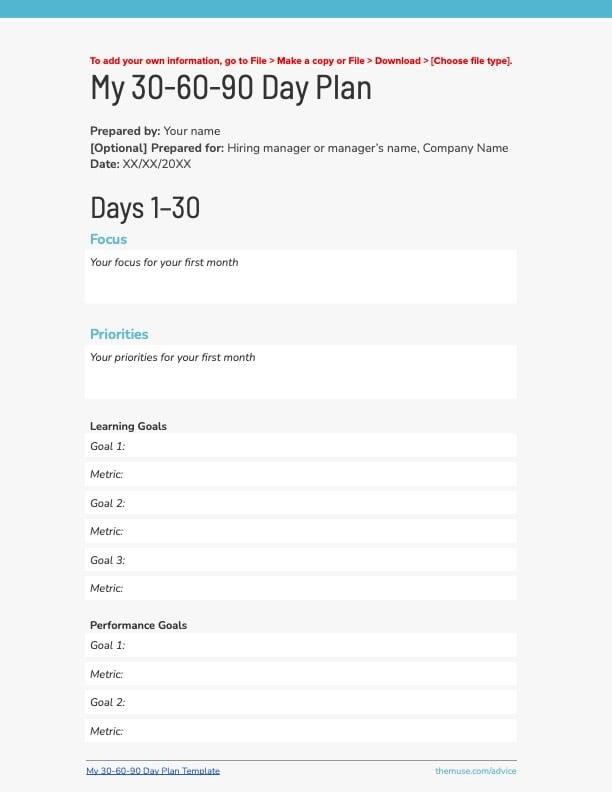
Not a fan of our formatting? (Or just need the words and nothing else?) Copy and paste the text below for each month of your plan.
My 30-60-90 Day Plan
Prepared by: [Your name] Prepared for (optional): [Hiring manager or manager’s name, Company Name] Date: [MM/DD/YYYY]
Days [1–30/31–60/61–90]
Focus: [Your focus for your first month]
Priorities: [Your priorities for your first month]
Learning Goals
- [Your first goal.] ( Metric: [How you’ll measure your first goal])
- [Your second goal.] ( Metric: [How you’ll measure your second goal]
- [Your third goal.] ( Metric: [How you’ll measure your third goal])
Performance Goals
- [Your first goal.] ( Metric: [How you’ll measure your first goal])
Personal Goals
30-60-90 day plan example
Use our 30-60-90 day plan template to start creating your own plan. If you’re stuck on how to fill it in, this example can provide some inspiration.
Focus: Learning
Priorities: Get up to speed on my role, team, and the company as a whole. Understand the expectations my manager has for me, learn how the internal processes and procedures currently work, and start to explore some of the challenges facing the company and my role.
Learning goals:
- Read all of the relevant internal materials available to me on the company wiki or drive and ask my manager for recommendations of articles, reports, and studies I should review. ( Metric: Reading completed)
- Get access to the accounts (email, task management software, customer relationship management platform, etc.) I’ll need to do my job. Spend time familiarizing myself with each of them. ( Metric: Task completed)
- Listen to five recorded sales calls by seasoned teammates. ( Metric: Five sales calls listened to)
- Meet with someone on the account management team to learn about what new clients can expect from the onboarding process. ( Metric: Task completed).
Performance goals:
- Make my first sales calls to key clients and prospects. ( Metric: Three sales calls completed)
- Ask my manager for feedback on my output and performance. Document the feedback so I can incorporate it in my future performance. ( Metric: Task completed)
Personal goals:
- Meet with my manager and as many other new coworkers as possible. Introduce myself and learn about their roles within the organization. ( Metric: Five meetings held)
- Set up recurring meetings with everyone I’ll need to work with on a regular basis—including cross-functional and external partners. ( Metric: Regular meetings set and attended)
Focus: Contributing.
Priorities: Perform my role at full capacity, with a decreased need for guidance. Start to explore how I can make a unique impact within my role and the company.
- Complete an online training course to learn how to better use our customer relationship management platform. ( Metric: One course completed)
- Shadow a seasoned member of the team, listen in on at least three of their sales calls, and document what I learn from observing their approach. ( Metric: Task completed)
- Make five sales calls a week to key clients and prospects. ( Metric: 20 calls completed)
- Ask a seasoned member of the team to observe at least one of my sales calls and give me feedback about how I can improve. ( Metric: Task completed)
- Listen to at least four of my own recorded calls and note self-feedback ( Metric: Four calls listened to)
- Ask for feedback from my manager and coworkers, and document the feedback so I can incorporate it in the future. ( Metric: TBD)
- Schedule coffee or lunch with someone from the company I haven’t gotten to know yet. ( Metric: Task completed)
Focus: Taking initiative.
Priorities: Start assuming more autonomy and finding small ways to practice leadership skills. Start to explore goals for the rest of the year.
- Identify and sign up for a conference, webinar, or online course that will aid in my professional development. ( Metric: One conference, course, or webinar signed up for)
- Analyze my performance so far and establish key metrics I care about (sales, leads, revenue, etc.). Implement a test to try to improve that metric. ( Metric: Task completed)
- Perform my core responsibilities at a higher level based on the metrics I outlined. (Close more sales, increase revenue, etc.) ( Metric: TBD)
- Develop an idea for a new project or initiative I can spearhead, and pitch it to my manager. ( Metric: Task completed)
- Complete the project or initiative I outlined and get feedback from key stakeholders. ( Metric: Project/initiative completed and feedback received from three key stakeholders)
- Get involved extracurricularly within the company by signing up for the corporate volunteer day or a company-sponsored club or sports team. ( Metric: Task completed.)
With our 30-60-90 day template, examples, and guidelines, you’re well-equipped to land the job you’re after or tackle your first 90 days in your new role. Happy planning!
Regina Borsellino also contributed writing, reporting, and/or advice to this article.
Newly Launched - AI Presentation Maker

Researched by Consultants from Top-Tier Management Companies

Powerpoint Templates
Icon Bundle
Kpi Dashboard
Professional
Business Plans
Swot Analysis
Gantt Chart
Business Proposal
Marketing Plan
Project Management
Business Case
Business Model
Cyber Security
Business PPT
Digital Marketing
Digital Transformation
Human Resources
Product Management
Artificial Intelligence
Company Profile
Acknowledgement PPT
PPT Presentation
Reports Brochures
One Page Pitch
Interview PPT
All Categories
Top 10 90-Day Plan Templates for New Jobs with Examples and Samples

Deepika Dhaka
Are you starting a new job or taking on a new project and feeling overwhelmed by the enormity of the task ahead? According to research by Leadership IQ, over 46% of newly hired employees fail within the first 18 months, often due to a lack of clarity and direction. This is where a 90-day plan can make all the difference.
A 90-day plan is a strategic roadmap that outlines your goals, priorities, and actions for the first three months in a new role or project. By having a clear plan in place, you'll be able to hit the ground running, make a positive impact, and avoid becoming a part of that harrowing statistic.
For instance, imagine starting a new role as a Sales Manager. With a 90-day plan, you can set specific targets, prioritize your sales pipeline, and identify areas where you can add value to the team. This helps you succeed in the short term and sets the foundation for long-term success in your career.
10 Best 90-Day Templates for Employees and Hiring Managers
If you are seeking to craft a 90-day plan but struggling to figure out where to commence, explore this blog offering a plethora of popular templates that are currently assisting millions worldwide. These templates are meticulously designed to offer a lucid and user-friendly framework, complete with sections outlining your goals, identifying key stakeholders, and creating 90-day action plans.
The 100% customizable nature of the templates provides you with the desired flexibility to edit your presentations. The content-ready slides give you the much-needed structure.
Let’s explore these helpful resources!
Template 1: 90-Day Marketing Plan
Companies that regularly create and implement marketing plans are more likely to see a positive return on investment (ROI) than those that do not. If you're ready to boost your marketing game and drive real results, this PowerPoint Presentation is all you need. It guides you through creating the most effective 90-day plans for the online platform, social media engagement, and outreach. It includes different visual layouts to create a foolproof plan that is easy to communicate. Grab it now!

Download this presentation
Template 2: 90-Day Executive Plan
Are you an ambitious leader seeking to enhance your performance and achieve exceptional results? Look no further than our 90-Day Executive Plan PPT Set. This comprehensive resource covers all the essential elements, including effective strategies, optimization techniques, and actionable steps for implementing a valuable 90-day plan. Tailored for various job roles, such as marketing, human resources, and project management, this PPT Deck features visually appealing layouts for easy comprehension. Download today!

Template 3: 90-Day Marketing Plan PPT Slide
This PowerPoint Slide can assist you in defining your 30-60-90-day plans in a clear and structured graphic, ensuring that your project goals are in line with the company's overall objectives. The design is both simple and professional, providing enough space to list your tasks and sub-tasks effectively. By downloading this resource, you can enhance your motivation and confidence to excel in your new role. Take the next step and use this helpful tool to align your goals with your company's vision.
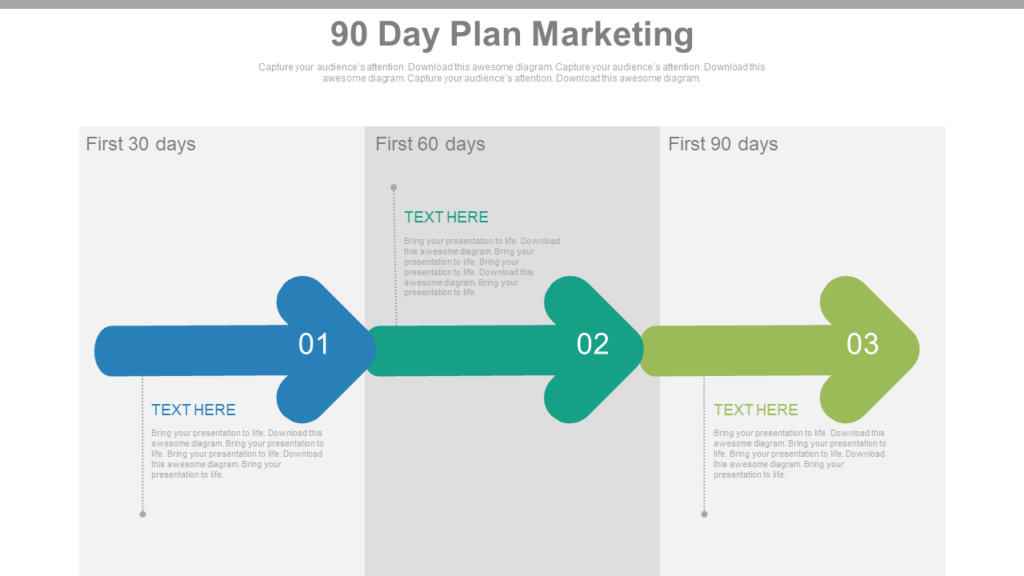
Download this template
Template 4: 30-60-90-Days Plan for Sales Improvement
This 30-60-90-day plan for sales improvement can help you achieve your goals by providing a structured approach to your sales strategy. It outlines key priorities for each phase, along with the corresponding key actions you need to take. By breaking down your sales goals into manageable chunks, you can focus on making measurable progress toward your targets. With this plan, you can ensure that you are maximizing your resources, identifying new opportunities, and building strong relationships with your customers. Download now!
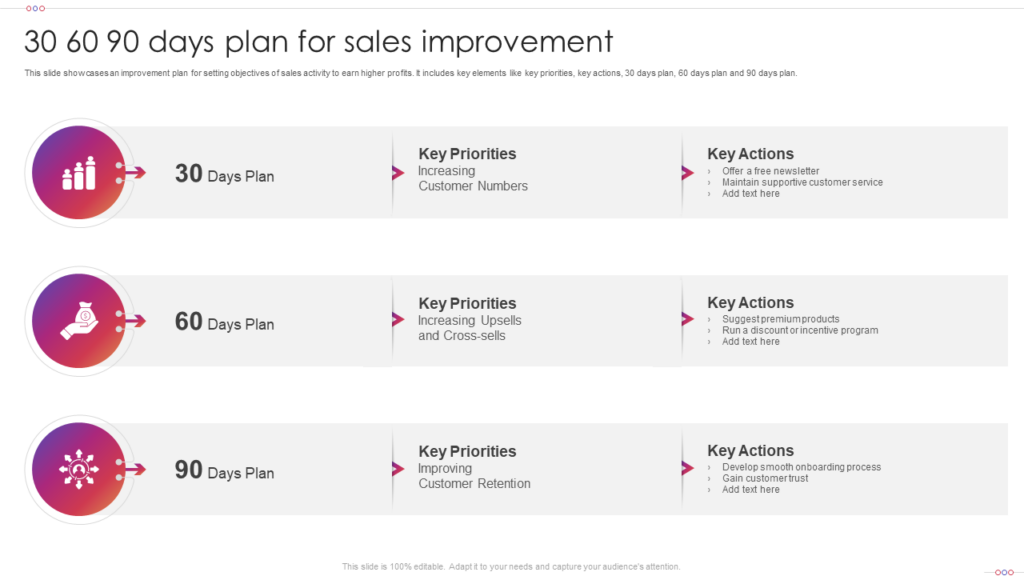
Template 5: 30-60-90-Day Plan Template
Demonstrate your key actions for a new job with this 30-60-90-day plan and showcase your current value and future potential. With this consolidated and easy-to-use template, you can effectively communicate your plan of action to your team, manager, or potential employer. It's the perfect tool to highlight your organizational skills, strategic thinking, and commitment to your new position. Download now and watch as you exceed expectations and achieve your goals!
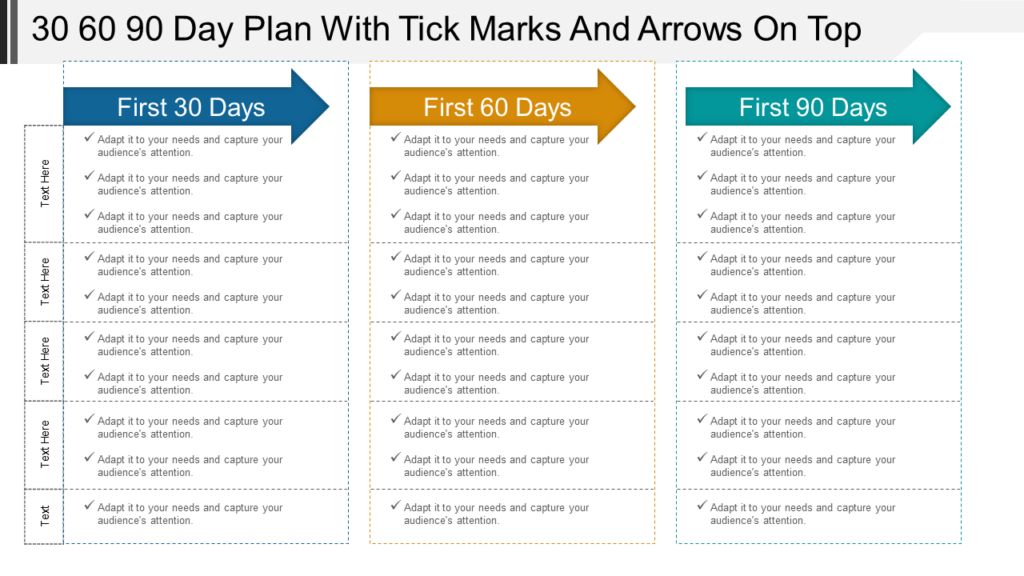
Template 6: Scalability Business Model with 30-60-90-Day Plan
Introducing our revolutionary PPT Deck - the ultimate solution for entrepreneurs and business leaders who want to take their ventures to the next level! With our comprehensive 30-60-90-day plan, you'll learn how to optimize your business model for scalability and sustainable growth. It covers essential steps such as setting a baseline, defining an action plan, and then building scalable programs. This PPT Deck is perfect for businesses of all sizes, from startups to established enterprises. Get it today!

Template 7: 30-60-90-Day Plan with Columns and Rows
If you need a simple and effective way to define your activities for the initial phase of your new position, explore this 30-60-90-day plan template created by our expert designers. Featuring rows and columns that allow you to outline your objectives, tasks, and deadlines, this template is the perfect solution for anyone looking to improve their productivity in an organized manner. Plus, with its intuitive design and easy-to-use format, you'll be able to start using it right away. Download now!
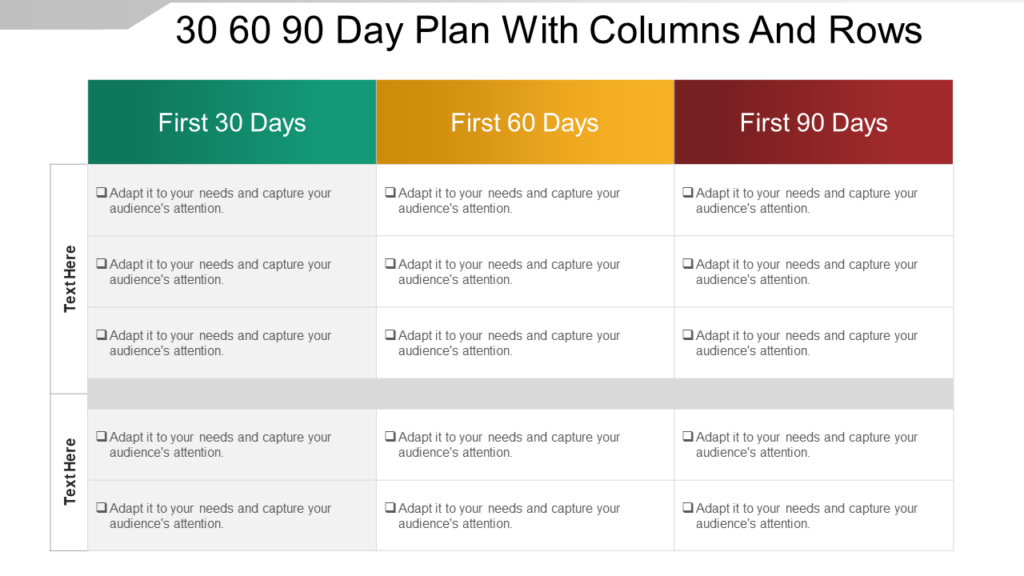
Template 8: 30-60-90-Day Plan for Quality Assurance
This 30-60-90-day plan for quality assurance is built around the principle of continuous improvement, which means that it is designed to be adaptable and flexible so that you can adjust your approach as you gather more data and insights into your quality assurance processes. By consistently monitoring your progress and making adjustments as needed, you'll be able to stay on track and achieve your quality goals within time. Download now!

Template 9: 90-Day Plan for HR
This comprehensive PPT Template includes detailed steps and strategies for optimizing your HR processes, such as streamlining recruitment, improving employee engagement, and enhancing communication. With this template, you'll be able to easily collaborate and delegate tasks, ensuring that everyone is on the same page and working towards the same goals. Try it today to build a dedicated workforce!
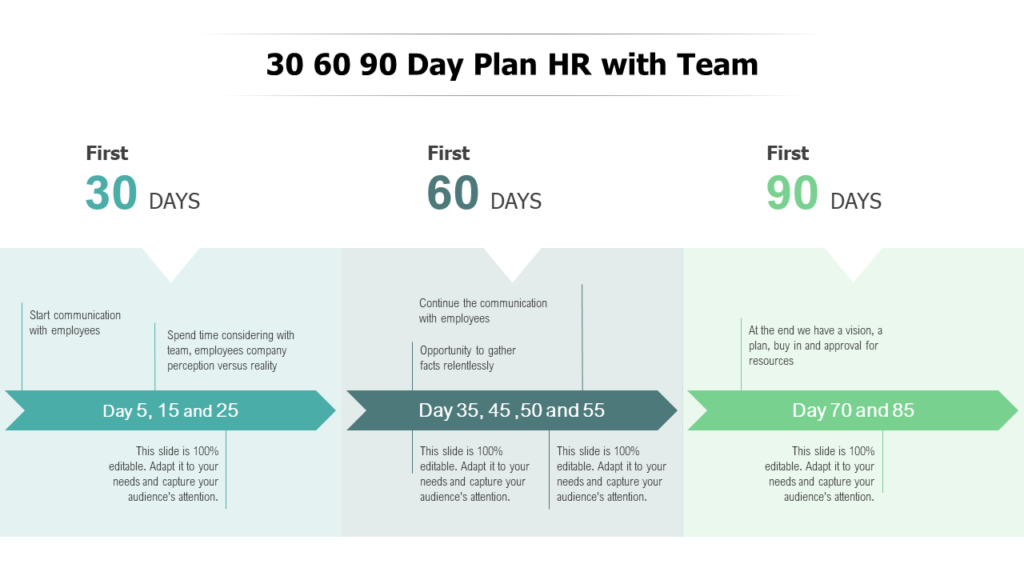
Template 10: Organization 30-60-90-Day Sales Plan
Showcase your potential as a sales expert with a 90-day plan PowerPoint slide that provides distinct segments for the initial 30, 60, and 90 days of your job duties. Utilize this platform to establish your strategies and essential objectives for delivering projects. This is an excellent opportunity to demonstrate your ability to prioritize tasks and produce tangible results. Get it now!
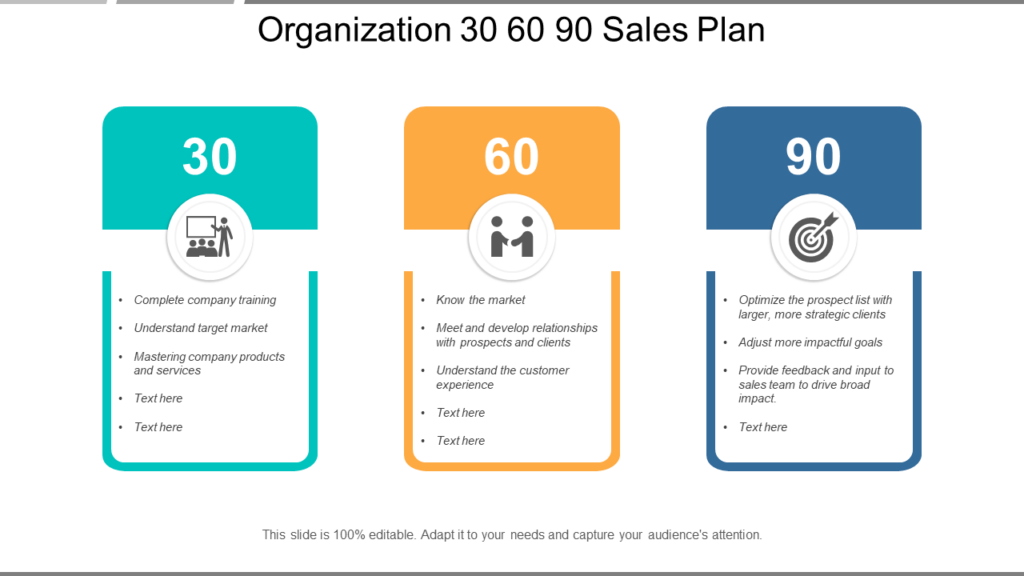
1, 2, 3 Months
A well-crafted 90-day plan can help individuals and organizations achieve their goals and set them on a path to success. Whether it's personal growth, career development, or business expansion, a clear roadmap and actionable steps can make a significant difference. As Antoine de Saint-Exupéry said, "A goal without a plan is just a wish." Therefore, it's essential to have a plan and work toward it diligently. With a 90-day plan, one can take small steps that lead to significant achievements for reaching the desired destination.
Now that you know why the 90-day plan is crucial, it's time to download these templates to get started. Download them once and use them forever!
P.S . If you are looking for Master Action Plan Templates, here’s a handy guide with popular samples and examples.
FAQs on the 90-Day Plan
How to write a 30-60 90-day plan.
To write a 30-60-90-day plan, you should start by researching the company and the role you are applying for. Identify the key responsibilities and objectives, and break them down into specific tasks for each 30-day segment. Define measurable goals and targets for each stage, and align them with the organization's overall strategy. Be sure to include any relevant training or development activities that you plan to undertake during this period.
What should be included in a 90-day plan?
A 90-day plan should include specific goals and objectives for the first three months on the job. It should outline the key responsibilities and tasks, along with the expected outcomes and deliverables. This plan should also include any training or development activities that will support your success in the role. It should be aligned with the organization's strategy and demonstrate your understanding of the company's goals and priorities.
What is the goal of a 90-day plan?
The goal of a 90-day plan is to establish a clear roadmap for success in a new role. It provides a framework for prioritizing tasks and achieving measurable results while aligning with the organization's overall strategy. A well-crafted 90-day plan demonstrates your understanding of the company's priorities, your ability to prioritize tasks, and your commitment to delivering results.
How do I make a 3-month work plan?
To make a three-month work plan, start by identifying the key responsibilities and tasks required to achieve your objectives. Break these tasks down into specific actions and prioritize them based on their importance and urgency. Assign specific deadlines to each task and define measurable goals and outcomes. Be sure to align your plan with the organization's overall strategy and identify any resources or support you may need to succeed. Review and adjust your plan regularly to ensure you are on track to achieving your goals.
Related posts:
- Top 10 30-60-90 Days Plan Google Slides Templates To Win Your Next Interview!
- How to Design the Perfect Service Launch Presentation [Custom Launch Deck Included]
- Quarterly Business Review Presentation: All the Essential Slides You Need in Your Deck
- [Updated 2023] How to Design The Perfect Product Launch Presentation [Best Templates Included]
Liked this blog? Please recommend us

This form is protected by reCAPTCHA - the Google Privacy Policy and Terms of Service apply.

--> Digital revolution powerpoint presentation slides

--> Sales funnel results presentation layouts
--> 3d men joinning circular jigsaw puzzles ppt graphics icons

--> Business Strategic Planning Template For Organizations Powerpoint Presentation Slides

--> Future plan powerpoint template slide

--> Project Management Team Powerpoint Presentation Slides

--> Brand marketing powerpoint presentation slides

--> Launching a new service powerpoint presentation with slides go to market

--> Agenda powerpoint slide show

--> Four key metrics donut chart with percentage

--> Engineering and technology ppt inspiration example introduction continuous process improvement

--> Meet our team representing in circular format

Home Blog Business Crafting an Effective 30-60-90 Day Plan for Job Interviews: Examples + Templates
Crafting an Effective 30-60-90 Day Plan for Job Interviews: Examples + Templates
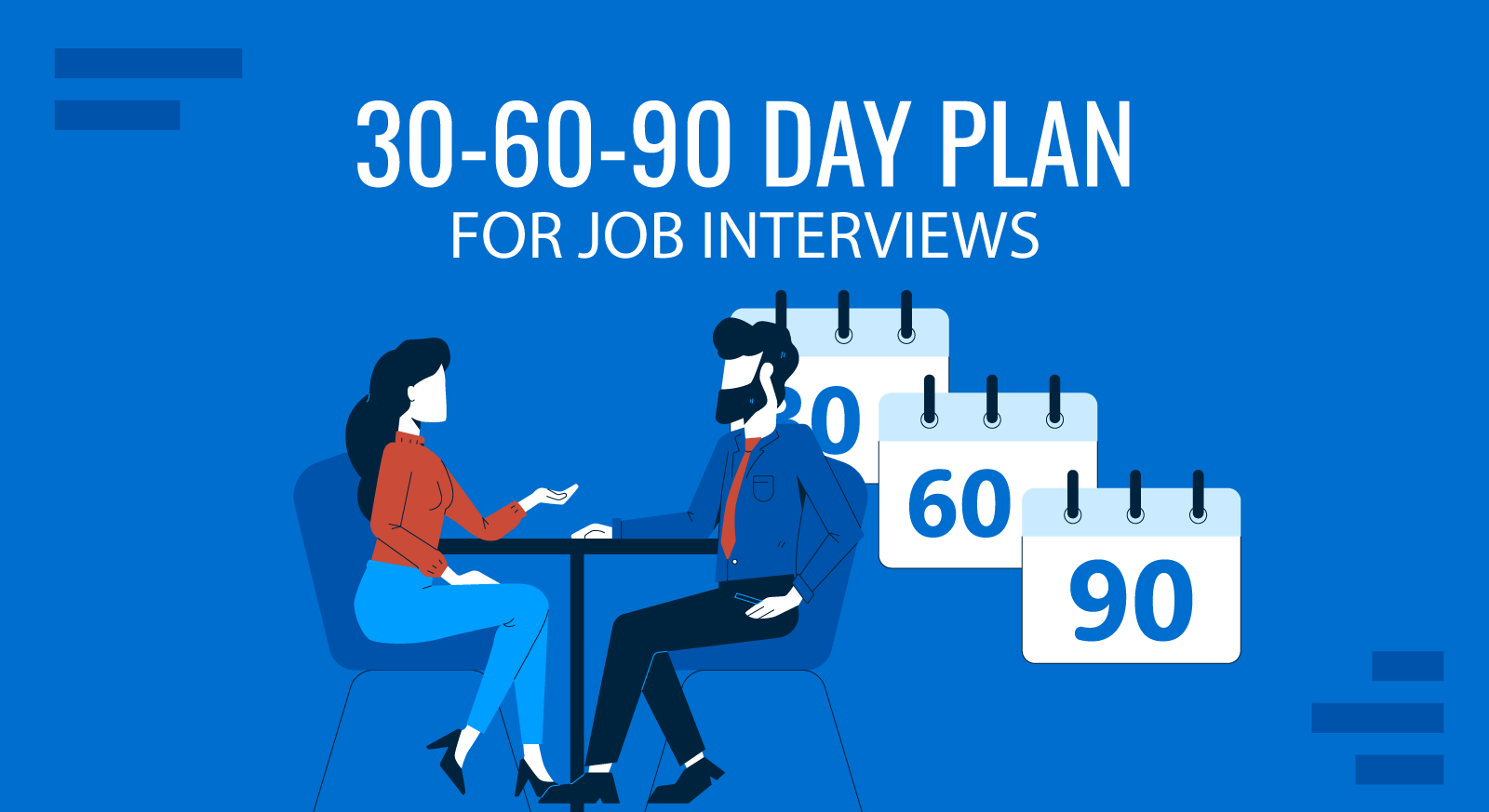
Some job interviews entail making or presenting a plan to show what can the new recruit offer the organization once he/she is hired. Depending upon the job title, there are various types of plans that one might require making such as perhaps a communications plan or project plan. However, the most common plan one might require making is a 30 60 90 day plan .
What is a 30 60 90 Day Plan?
Benefits for job applicants, benefits for employers, when to use a 30-60-90 day plan, key elements of a job interview 30-60-90 day plan, 30 days – learning phase, 60 days – evaluation phase, 90 days – optimize, start with an introduction, the first 30 days – learning goals, the first 60 days – initiative goals, the first 90 days – transformation goals, timeline & scorecard, make it readable, set smart goals, identify the company’s mission, meet the key stakeholders, be flexible.
- Determine How You Will Measure Success
Mintzberg’s 5Ps
Addie model, final words, 30 60 90 day plan templates for powerpoint.
Some employers ask candidates to present a 30-60-90 day plan. This helps employers understand the candidate’s skills, ability to create and manage measurable goals, foresight and willingness to be accountable for his/her work. The plan includes a roadmap to how the candidate aims to learn, add value and play a transformational role within the organization.
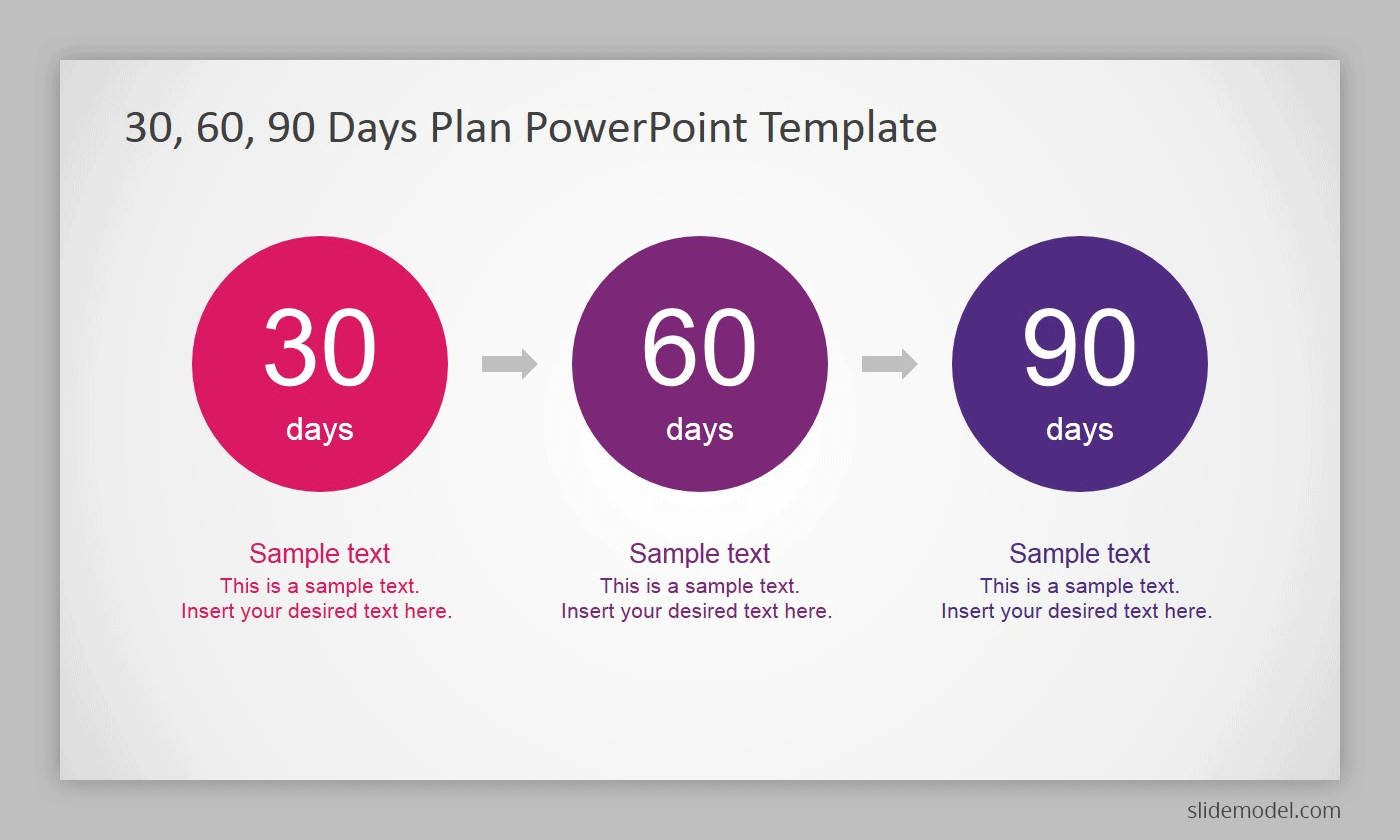
Organizations usually expect candidates to not only put in an effort to understand and evaluate the organization, projects and working environment; but to also add value, optimize procedures and bring positive change.
Benefits of Creating a 30 60 90 Day Plan
Whether your employer has asked for a 30 60 90 day plan or you take one along without any prior request from the potential employer, there can be a number of benefits for making such a plan. Similarly, the employer can better screen candidates if they ask for a 30 60 90 day plan.
Clarity in Job Expectations
One of the benefits of making a 30 60 90 day plan is that it provides clarity regarding what you might want from the new job. Furthermore, by dwelling into specifics of the advertised job description, you can also better understand the nature of the job and what you might have to offer to your potential employer.
If you’re someone rather new in your career or at an intermediate stage, making 30 60 90 day plans when trying to move up the career ladder can also be a way to sharpen your skills. You can see it as a tool that improves performance and productivity in the long run.
Better Preparation for a Job Interview
By making a 30 60 90 day plan, you can better prepare for a job interview. Many candidates can make the mistake of not paying attention to the job descriptions for dozens of jobs they might apply for. Once they receive an interview call, it can be tempting to skip the fine details. This is where you can fail during a job interview. Many times, it’s not the tough questions that can ruin your job prospects but a simple question that you failed to prepare for.
A Reflection of Professionalism
Some job applications create a 30 60 90 day plan even if the employer has not asked for it. This shows intent and determination, where a potential candidate has taken the time to better understand the job role and provide practical suggestions. Such an approach can make your potential employer see that you aren’t coming in with a casual approach. It also reflects on your professionalism in a positive way and can help you score some extra points.
Helps Thoroughly Screen Candidates
Many candidates can be good at expressing their views but not all that good at implementing action plans. A 30 60 90 day plan template can help employers screen candidates more closely by analyzing the candidate’s capabilities and asking tough questions.
Enables Gauging the Experience of Candidates
When a potential candidate presents a 30 60 90 day plan , it’s not just a reflection of his/her ideas but also a reflection of the experience and expertise they bring along. Some candidates might be suitable based on their expertise and experience for the job compared to others. For example, when choosing between two candidates for social mobilization of rural communities, one might have experience working with large organizations, but the other candidate might be more suitable based on his/her expertise at the grassroots level. Such a distinction might mean the difference between someone who is more in touch with the environment he/she needs to work in compared to the other.
Can Help Attract Better Candidates
Arguably, asking for a 30 60 90 day plan can help weed out candidates with a casual approach who might not even want to put in the time to make such a plan. Such candidates might not even apply for the position, leaving room for better candidates.
30/60/90 plans are often required at the time of job interviews and after an employee joins an organization. Such a plan is a reflection of how the employee intends to move forward during the first 90 days at the job, including how he/she shall learn, adapt, and perform at the workplace.
To put it in a nutshell, you should create a 30 60 90 day plan when applying for a job and it is quite likely you will need one when starting your new job. However, as mentioned earlier, even if the employer hasn’t asked for one, you can always create and bring along such a plan, be it a simple document or PowerPoint presentation. This is because such a move will give you clarity in your job role, will help you plan better for the job interview, and might even help you win a few extra points.
We also recommend you to read: The First 90 Days: Critical Success Strategies for New Leaders at All Levels by Michael D. Watkins to get some insight into how a 90 days plan can lead to success at the workplace. The book reflects upon leadership and career transitions. Joining a new job with a better salary and a few extra perks should not ideally be a goal. Negotiating with your new employer, moving up the career ladder, and ensuring success at the workplace requires leadership skills, your ability to bargain with your employer, team, and external stakeholders, is equally important.
How to Create a 30 60 90 Day Plan for a Job Interview?
If you have a job interview where you might require using a PowerPoint presentation to reveal your 30-60-90 day plan, you should focus on the key elements of the plan.
The key elements of a 30-60-90 day plan for a job interview entail understanding processes, people, procedures, products and competition, evaluating processes and provide an action plan for optimization and transformation within the organization.
The first 30 days entail the learning phase, where you must understand the processes, procedures, your team, product and the competition.
Process, People and Procedure
The first 30 days are to get acquainted with your new job. The objective is to understand the team, processes and procedures. Understanding how things work within the organization would be key to moving things forward. Many project managers can become disconnected from company processes and their own team, leading to bad decisions and subordinate resentment. During your job interview don’t try to show that you know everything, since everyone needs to learn about the new company before they can take meaningful steps.
Product and Competition
During the first 30 days you will also be required to understand the product or service, its key features, the clientele and how competitors might be a threat to it.
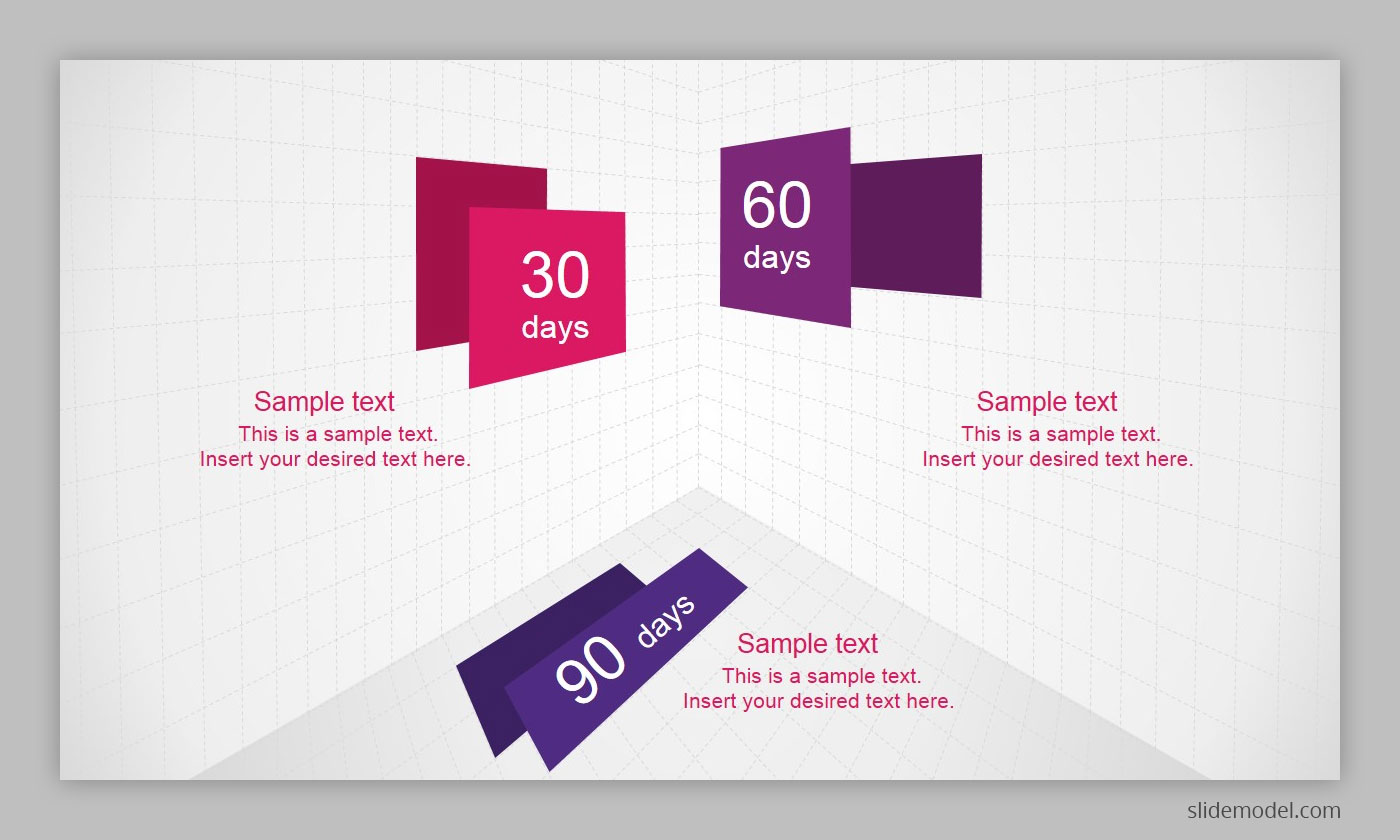
As evident from the aforementioned, the first 30 days, therefore, are all about learning the basics, followed by the next 30 days where you would move forward to the evaluation phase.
Evaluate Current Processes
The next 30 days (60 days) will include assessing current processes to understand how things work and to identify room for improvement. You might want to create a SWOT analysis to determine strengths, weaknesses, opportunities and threats. This will also help you allocate resources in the best possible manner to optimize your impact.
Evaluate Changes
Once you have evaluated processes, you now must try to evaluate grounds for bringing meaningful change. For example, you can identify cost-saving initiatives, methods for reducing waste, improving processes, lower per unit cost, etc. During this time, you would also be acquainted with the team (during the first 30 days) to determine what kind of change might be rational and what changes might lead to employee resentment and a possible backlash.
The next 30 days (90 days) would conclude 3 months, which is also usually the probation period for employees. This is the time when you need to deliver, or you might find yourself looking for a new job. If you set out with SMART goals, you should be fine during this time.
Initiate Action Plan
Based on your specific, measurable, attainable, realistic and time-bound (SMART) goals, you will require initiating your action plan. This will be a detailed plan with timelines and a scorecard to measure the success of your strategies.
Implement New Strategies and Procedures
During the last 30 days of the 30-60-90 day plan, you should start rolling out your new strategies and procedures. For example, a new process might be rolled out during this time or initiatives to cut costs and improve efficiency might be initiated.
Practical Example: How to Create a 30-60-90 Day Presentation for a Job Interview?
Now that we have discussed the basics of a 30-60-90 day plan, let’s take a look at how to create a 30-60-90 day plan example presentation to show your potential employer how you intend to add value and improve the processes, procedures, and project delivery.
There is no point jumping right into the topic. You should start with a brief introduction of the topic at hand and explain what the plan is about. This is the section of the presentation that starts with a brief explanation of the topic.
You should incorporate your goals within your presentation, starting with the learning phase or the first 30 days. You should briefly explain how you intend to learn about the processes, procedures, people and corporate culture, product or service and the competition to evaluate room for improvement. If you don’t have a lot of information regarding the organization, you can create sample goals based on hypothetical examples.
Many people can end up joining a job and thinking they have made a mistake. You need to have absolute clarity that the new job is something you are interested in, are looking to take the initiative to move forward with and can add value to the organization. Speak with clarity regarding your goals and if necessary, use hypothetical examples to give an example of what you might bring to the table.
You can also discuss strategies used by competitor organizations and even present a SWOT analysis in your presentation. Your information during this time might be limited regarding the organization, since you are unlikely to know specifics. But that’s alright, since employers expect the candidate to put in an effort in their plan and not know everything regarding the organization at the time of the job interview.
Based on the learning phase (first 30 days), you must set goals for taking initiative. As mentioned earlier, this is the evaluation phase where you would look for bringing changes to processes, procedures and perhaps team orientation to set out an outline for what might be rationally achievable. You can set SMART goals with indicators in the form of a scorecard for this purpose.
This part of your First 90 Days in a New Job presentation will focus on the change you intend to bring and the way you ensure it. You can explain how you intend to integrate your team with your organizational mission, vision, core values and bring improvement to existing processes, procedures and methods. You can also refer to a SWOT analysis to explain how your methods might be the right way forward for the organization. For example, in case the company is facing declining sales, you can incorporate a plan for improving market share, competing more effectively against competitors who pose a threat to the business and how you intend to capitalize on available opportunities (e.g. brand goodwill or making better use of existing marketing resources).
Make sure that you incorporate a timeline and scorecard in your 30-60-90-day presentation. This will allow your potential employer to assess your capability of organizing your goals and get an overview of what your plan might look like at a glance. The scorecard will enable you to show how you intend to measure success and achieve your goals. This will help give a positive impression regarding your capabilities and clear out any possible confusion that your audience might have regarding your plan.
Tips for Making Your First 90 Days in a New Job Presentation
Making a plan for your first 90 days in a new job presentation is too complicated might confuse your potential employer. One of the key aspects of making a robust 90 days plan is that it should be easy to understand. Try to keep the layout of the plan easy enough for your audience to understand and pay special emphasis on legibility. If it’s a document, use standard fonts. If you need to present your plan, do away with flashy templates and over-the-top animations and try to keep the layout easy to read and simple enough to present. And of course, avoid death by PowerPoint.
It goes without saying that the goals you set out should be SMART, i.e. specific, measurable, achievable, realistic, and time-bound. You can analyze your goals once your plan is complete to ensure that they comply with SMART goals . Since this is a 90 days plan, you should try to focus on goals that are based primarily on the first 90 days, even if you plan to discuss a few long-term goals. You can also use a template that can help you easily layout your plan in the form of PowerPoint slides. For more information, we also recommend our section of SMART goals templates .
To create a 30/60/90 plan that is well received, you should ensure that your plan is in line with the company’s vision and mission. You can do a bit of research regarding that prior to your job interview. If you are making a plan after being hired, it is even more critical to ensure you don’t make a plan that can end up colliding with the corporate culture of the organization. To ensure this, you need to better understand the vision and mission statements of the company and any other frameworks they might have in place related to them.
While it’s unlikely that you will be able to meet the key stakeholders at the time of the job interview, when making a 90 days plan after joining a job, you can meet the key stakeholders to help refine your plan. This would include both internal and external stakeholders such as peers, senior management, line managers, vendors, partner organizations, etc.
While you might think you have a robust 30 60 90 day plan. It isn’t necessarily going to be perfect for your potential employer. You need to leave room for flexibility and adapt to potential challenges and suggested changes. Be it at a job interview or when making a plan after being hired, you need to ensure your plan isn’t rigid and can be adapted to unforeseen circumstances.
Determine How You Will Measure Success Example
To measure success, you will require adding a few KPIs (Key Performance Indicators). For example, if you are hired as a communications expert in the development sector, you will be required to elaborate upon how you can use digital technology to benefit the organization. Are you looking to overhaul the company’s social media presence? Are you looking to change the website design of the company website with a responsive UI? Do you plan to reach a specific number of targeted beneficiaries under a human development program using digital technology? Your KPIs should be in line with your SMART goals and should be realistically achievable during the laid-out timeline.
Alternatives to 30-60-90 Day Plans
There are a few alternatives to the 30-60-90 day plan. Let’s briefly take a look at a few 30-60-90 day alternatives.
Mintzberg 5Ps have been around since 1987. These 5Ps were the brainchild of Henry Mintzberg and include; Plan, Ploy, Pattern, Position and Perspective. These 5Ps serve as a roadmap for making a business strategy to make the most out of an organization’s strengths.
ADDIE stands for Analysis, Design, Development, Implementation, and Evaluation. Being an Instructional Systems Design framework, the ADDIE model is used by instructional designers and training developers for developing courses.

Source: ADDIE Model PowerPoint template by SlideModel
The GROW Model is used by executive coaches. The model is meant for setting goals and problem-solving . The model can be understood simply by its name, which stands for Goal, Reality, Obstacles, Options and Way Forward.
Even if you are not asked to bring a 30-60-90 day plan, it might not be a bad idea to bring along one to improve your chances of scoring a job. A 30-60-90 day plan is essentially meant to assess the capabilities of a potential employee and what change he/she might bring to an organization. When making such a plan for a job interview, you should gather as much information regarding the organization as possible. You should also look into competitors, weaknesses in procedures, financial outlook of the organization, etc. This information is usually available on the organization’s website, via news articles and from companies dealing with trends related to the industry.
Your 30-60-90 day plan needs to be rational, with SMART goals and measurable success. You should not jump to conclusions but rather focus on rational approaches which might be implemented should you get the job. You should also account for aspects like a rigid corporate culture, possible non-cooperation of coworkers and procedures which might make it hard to implement your goals. In such a case you can mention pre-conditions for your 30-60-90 day plan to be successful. This is because many such plans can fail due to the bad working environment prevalent in particularly large organizations, where petty politics and slow procedures can be the bane of newly hired employees looking to implement strategies which might otherwise look rational.
If you are looking to create a professional plan for your new job interview, check out our 30 60 90 Day Plan Templates .
1. Free 30 60 90 Day Plan PowerPoint Template
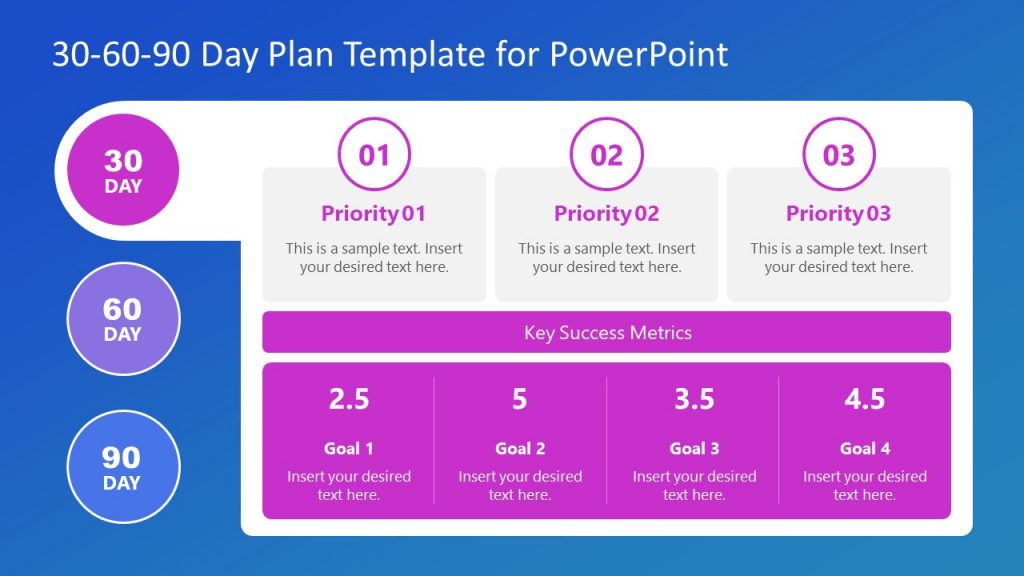
Free 30 60 90 Day Plan PowerPoint Template is a 3-slide presentation for planning presentations. You can utilize slides of 30, 60, and 90 days planning to visualize goals and set realistic deadlines. Together, you can present a strategy for success in the first 90 days on job or a new project.
Use This Template
2. 30-60-90 Days Plan PowerPoint Template
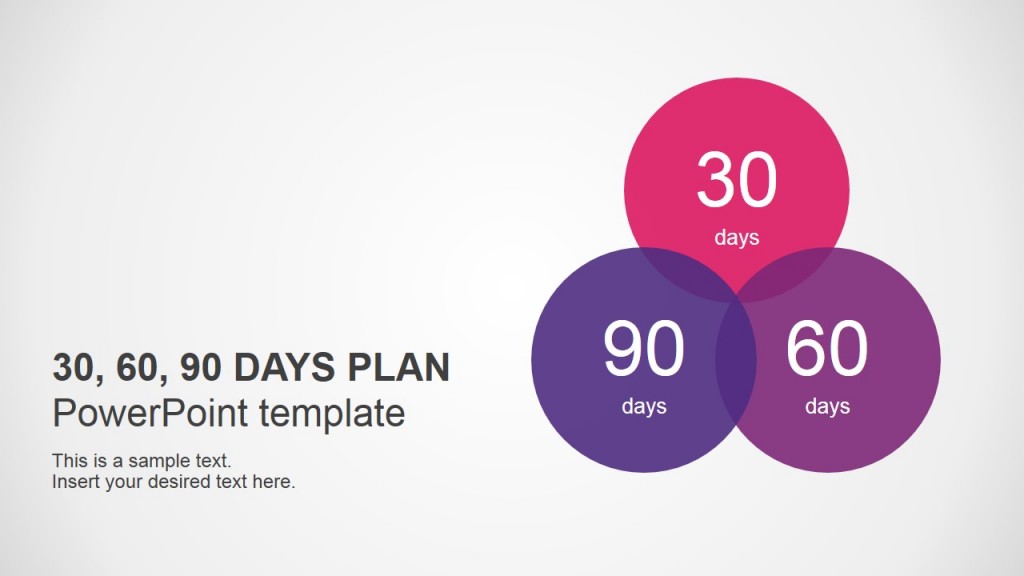
This is our most popular 30 60 90 Day Plan Template for PowerPoint, the most recognized by jobseekers and expected by employers. This is a powerful tool in the final stages of a job interview process.
3. Simple 30 60 90 Day PowerPoint Template
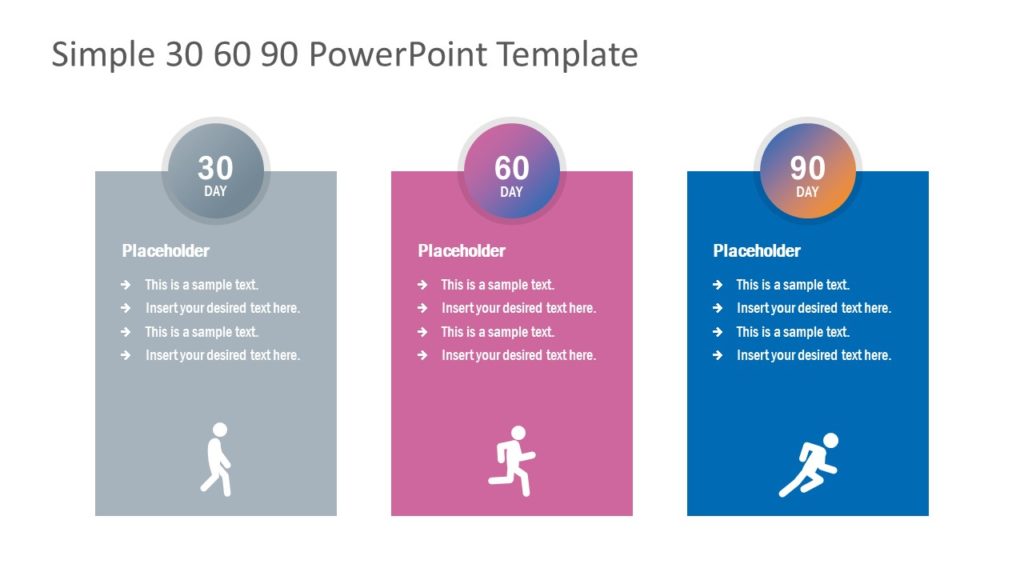
The Simple 30-60-90 Day Plan Template for PowerPoint is an infographic layout of business and management concepts. This tool helps recruitment officers to analyze candidate’s interpersonal skills, clear understanding of job descriptions, and passion for work.
4. 100-Day Plan PowerPoint Template

The 100-Day Plan Template is a timeline and planning presentation. This template includes 5 slides of colorful diagram design. This template also includes a Gantt chart format of time scheduling for management plans.

5. 30-60-90 Day Planning Template for PowerPoint

The 30-60-90 Day Planning Template for PowerPoint is a strategy and planning concept presentation. The timeline of days is represented by a blue ruler shape containing entries of days instead of centimeters. The circular shapes give an effect of a magnifying glass on 30 – 60 – 90 day milestones.
6. 30-60-90-120 Day Plan Slides for PowerPoint

The 30-60-90-120 Day Plan Slides for PowerPoint is a tabular layout to present an action plan in any managerial capacity. It is a one-step further to 30-60-90 day plan to map project goals and deliverables within four milestones, including the 120 day plan option.
7. 30-60-90 Day Plan Slides for PowerPoint
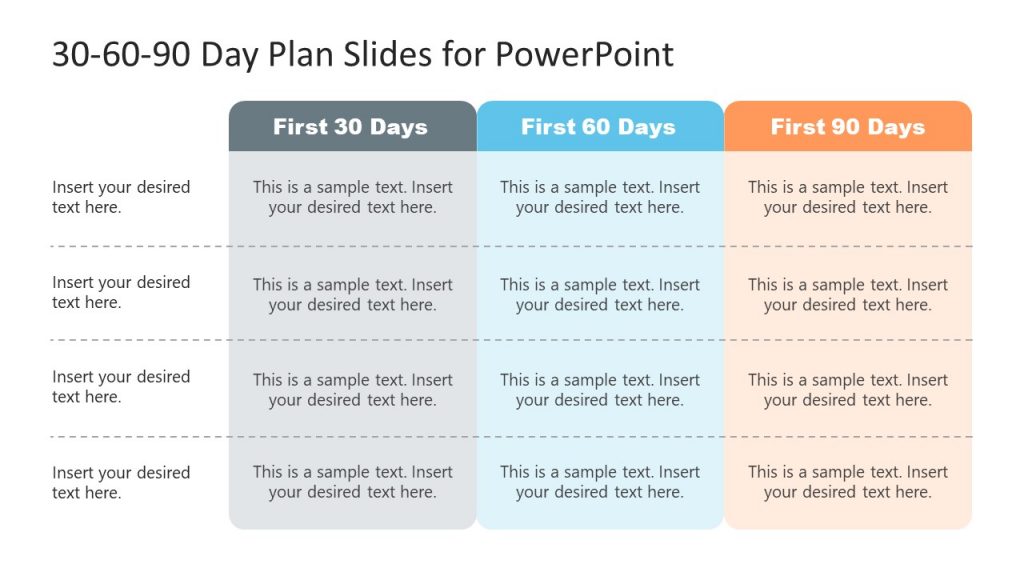
The 30-60-90 Day Plan Slides for PowerPoint is a business planning template to map out main goals. In terms of 30, 60, and 90 days, you can highlight the deliverable of a project, operation, or job. Business owners, startups, and entrepreneurs use a 30-60-90 day roadmap template to highlight the company’s course of action.
8. 90 Day Plan Template Slides for PowerPoint

The 90 Day Plan Template Slides for PowerPoint illustrate a line gauge of tens. It is a timeline & planning PowerPoint template for all types of industry strategies. The concept can be applied to projects for organizing and prioritizing processes.
9. 90-Day Plan PowerPoint Template

The 90-Day Plan PowerPoint Template is a planning presentation tool used by business professionals. This template lets users personalize their 30-60-90 days plan of success for executive meetings. New managers and leaders use the 90-day plan template to showcase their first 30, 60, 90 days plan on a new job.
10. 30-60-90 Day Planning PowerPoint Template
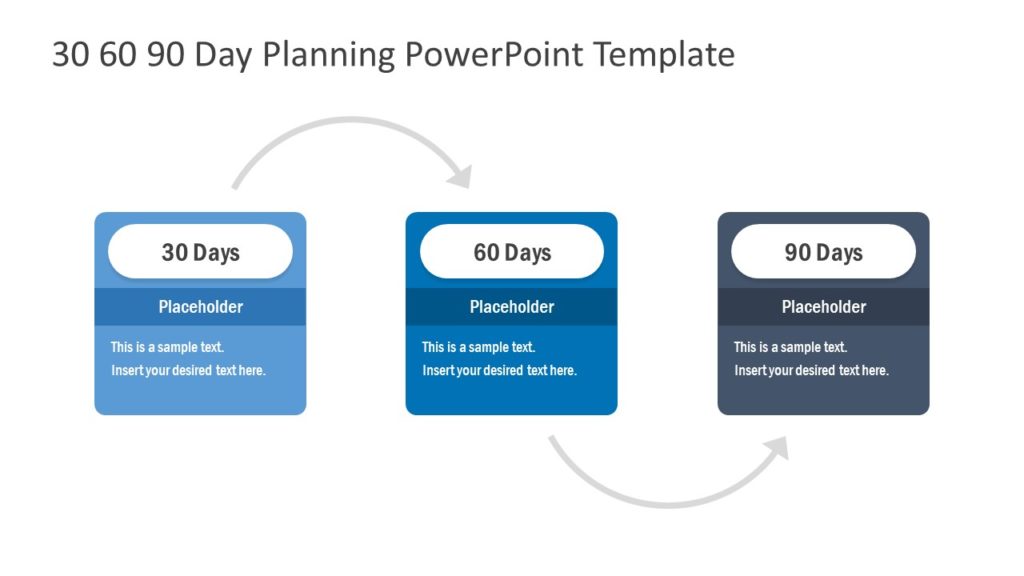
This 30 60 90 day plan template is a clear example of how to generate a planning in three simple steps. This template is 100% editable, allowing the user to customize the content and visual appearance.
11. 30 60 90 Days Plan Timeline Template

The 30 60 90 Days Plan Timeline Template is a very useful template for project management. It will allow you to present your 30 60 90 day plan with a weekly planning of each task and a specific Gantt chart generating a clear roadmap.

Like this article? Please share
30-60-90, Interview, Job Interview, Planning, Strategy Filed under Business
Related Articles

Filed under Business • April 22nd, 2024
Setting SMART Goals – A Complete Guide (with Examples + Free Templates)
This guide on SMART goals introduces the concept, explains the definition and its meaning, along the main benefits of using the criteria for a business.
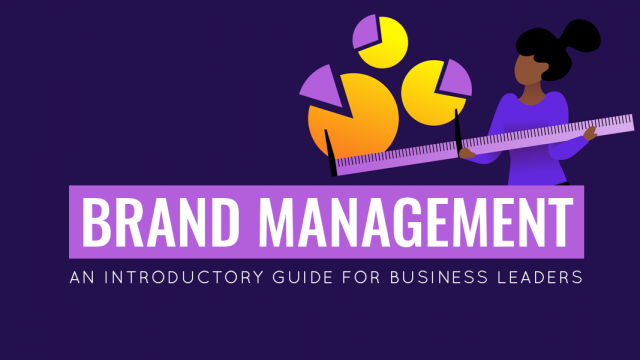
An Introductory Guide to Brand Management For Business Leaders
Did you know that displaying consistent branding across different sales platforms can increase revenue by up to 33%? That’s a good pocket of growth. But it’s hard to tap into without a systemized approach. Enter brand management. What is Brand Management? Brand management is a multi-facet process of presenting and supervising the promotion of a […]

Filed under Business • April 17th, 2024
How To Make an Interview Portfolio (Examples + Templates)
Transform your job seeking experience into a smooth process by learning how to make an interview portfolio. Guide + Examples here.
Leave a Reply

What Is a 30 60 90 Plan?
When should i make a 30-60-90 day plan, why is a 30-60-90 day plans important, how to write a 30-60-90 day plan: tips for 2024, long-term goals, final thoughts, how to write a 30-60-90 day plan (2024 guide).
Updated January 10, 2024

All products and services featured are independently selected by WikiJob. When you register or purchase through links on this page, we may earn a commission.
If you are about to start a new job or are preparing for an interview a 30-60-90 day plan will help you on your route to success.
The 30-60-90 plan is a document that outlines your first 30, 60 and 90 days in a new job.
It should detail everything you want to achieve in your first three months of employment and the SMART goals to facilitate this.
If done correctly, this plan will help make a good first impression, for it shows your employer or recruiter that you are motivated, dedicated and have taken the time to learn about the company.
For those wanting to freelance or register as self-employed , a 30-60-90 day plan gives you focus, and a solid route to success.
If you are new to career planning , creating a 30-60-90 day plan could seem complicated and unnecessary.
However, creating goals and actionable steps is proven to help you reach success more efficiently.
This article will instruct you on creating the best plan for you, with examples to get you started.
The purpose of a 30-60-90 plan is to set the groundwork for career advancement.
You should make:
30-60-90 Day Plan for Interview: In the final stages of your interview process 30-60-90 Day Plan for New Job: In the first week at your new job
Showing your plan in the last stages of the interview process separates you from the rest of the candidates.
It shows you are serious about your career and have the skills to develop a strategy.
The one you create during your initiation week will be similar to what you showed at your interview.
The only difference is that you will now have to deliver on what you have committed to.
30-60-90 day plans are not just useful for recruitment and impressing your new employer. These plans can also be used:
- For project management
- After performance reviews
- To help with personal development
30-60-90 day plans offer many benefits, including:
- Defining your priorities
- Creating a clear focus for the next three months
- Facilitating a smooth integration into your new company and role
- Showing you are capable of self-management skills
- Indicating that you are worthy of investment
- Highlighting the areas you need to improve
What Should a 30-60-90 Day Plan Include?
In each section of your 30-60-90 day plan, you will have four main elements:
- Your specific focus
- The top priorities
- SMART goals
- The metrics you will measure your success
Your focus for each month will be different, and depending on the success or failure of the previous month, you may need to change the next focus for the next month.
Usually, in month one, you will focus on learning about your role, getting to know your team, and understanding company policies and procedures.
Month two is more about contributing, planning and developing skill sets .
Month three is about the execution and preparing yourself for the next stage.
Top Priorities
Once you have established your main focus for the month, you need to outline your priorities.
These should be more specific than your focuses and less specific than your SMART goals.
For example, in your first month, your focus could be to learn the company's policies and procedures.
Depending on your job role, a priority may be to learn the internal processes first.
A priority for the second month could be to begin working independently.
A third-month priority may be to present a solution to a problem the company is currently facing and prepare for your performance review.
SMART Goals
Goal-setting is your roadmap to achieving your priorities.
For your 30-60-90 plan, you want to focus on short-term goals .
These are the small steps you take that make achieving success easier.
Every goal should follow the SMART acronym, meaning they should be:
You are not limited to one goal; however, you also should not overwhelm yourself.
You can also add goals later if you feel you need to adjust your direction or have completed the ones you already set.
Your goals should also cover all areas of personal and professional development, so try to write goals for the following categories:
- Learning goals – The knowledge and skills you need to develop to be successful.
- Performance goals – Concrete things you want to complete, such as workshops and daily targets.
- Personal goals – The relationships you want to develop, how you want to be viewed by your colleagues.
Measurement is part of your SMART goal acronym; however, it should be highlighted as your final section to give you a clear indication of when you have achieved something.
A metric could be a specific date, value, a completed task or time spent doing something. Basically, anything that allows you to track your success.
To find out which jobs fit your personality best, visit our partner CareerFitter and take the Career Test for FREE .
Pass the Quiz for FREE
Before writing your 30-60-90 day plan, consider the following:
Step 1 . Know Your Why
Before you make your plan, you need to know why you are making it.
Your reasons could be:
- For you and your manager to understand each other better
- So you get the support you need
- To make the most out of your employment
- To facilitate your career strategy
Step 2 . Understand Your Role
Use the job description to help you understand what exactly you are being hired to do.
Your employment needs to benefit the employer so ensure that your priorities and goals feed into your job description.
Step 3 . Ask the Unpleasant Questions
In interviews and at the beginning of our employment, we tend to shy away from questions about money and promotions .
No one wants to seem ungrateful or that they are overstepping.
However, if you do not ask, you will not know what a realistic goal is.
Try wording your questions like:
- ”What is the typical or average time for a promotion?"
- ”How often do promotions come up?"
- ”What is the typical route to getting a promotion?"
If your goal is to get a promotion fast , you need to know what time frame you are working with.
There is nothing wrong with being curious, and your manager may appreciate your enthusiasm.
Step 4 . Get to Know Your Colleagues
Gaining the trust of your colleagues will help you understand the company quicker.
As you and your colleagues get to know each other, they will share their experiences at the company: which managers are friendly, how often promotions come up and what they have done in their own career development.
All this information will help you gauge what goals you can achieve and how.
Step 5 . Accept That You Will Have to Be Flexible
Many external factors can affect your plan, from pandemics to restructuring to technological advancements.
Be prepared that you may need to make adjustments and that things may take longer than you want.
Step 6 . Try to Create Your Plan With Your Manager
Creating your plan in the first week of your employment with your manager is the ideal scenario.
It allows both of you to get clear on expectations, responsibilities and time frames.
Do not hesitate to broach the topic first, as it may not be something they actively do.
Your manager might not be used to having a proactive employee and will be impressed by your initiative.
Alternatively, they may not be a supportive manager. In this case, gather as much information as you can and create your own plan.
It is important to note that if your manager is not forthcoming with feedback or wanting to develop a plan with you, you may be working in a hostile environment.
One of your priorities could then be to initiate a change in the company or learn all you can from them and look for another job.
Step 7 . Decide What Success Looks Like
Everyone has a different definition of success.
For some, it is being the top salesperson and making the most money.
For others, it is getting control of their personal finance and being content in their professional and personal life.
Before setting your goals, decide how you are going to define and measure your success.

How to Create a 30-60-90 Day Plan With Examples for 2024
There is no definitive way to write a 30-60-90 plan. You need to include specific things, but the process and format are whatever works for you.
You may want to start chronologically, deciding what comes first and ending with your 90-day goals.
Alternatively, you can work backward.
To use this method, visualize where you want to be in three months and work your way back to the present day, making a note of all the steps you need to take.
If you have practiced law of attraction you will know that visualizing what you want to achieve is an essential part of getting there.
Depending on your job role and industry, your priorities and goals will be different.
A salesperson will have a very different plan to someone working in marketing, who will have a different plan to someone working in healthcare.
The following examples are general focuses, priorities and goals that could be applied to almost everyone.
However, your plan should be specific and personal to you.
Example of a 30-Day Plan
Focus: Settling in and getting to know my new surroundings. Priorities: Learn the essentials of my role, learn who my team members are and the company culture. Understand the expectations of my manager and how the internal processes work. Learning goals: Gain access to all accounts I need to do my job and familiarize myself by the end of week one. Metric: Task completed Read all materials available to me regarding internal processes and procedures, and ask my manager for additional recommendations by day 15. Metric: Reading completed Shadow a colleague to familiarize myself with the workday and workflow by the end of day 7. Metric: Successfully spent the day shadowing. Make notes of company culture , including how breaks and lunches are assigned/taken, how feedback is given, who seems approachable and the favored communication techniques and language used by day 21. Metric: Confident understanding of company culture. Performance goals: Complete three tasks or responsibilities without supervision or guidance by day 14. Metric: Completed a task/made a sale/contacted three clients. Arrange a meeting with my manager to get constructive feedback and new targets by day 21. Metric: Meeting confirmed. Personal goals: Introduce myself to all team members and learn about their roles in the company and something about their personality by day 30. Metric: Task completed.
Example of a 60-Day Plan
Focus: Actively start contributing. Priorities: Independently perform my role at full capacity and begin to assess if and how things can be improved. Learning goals: Attend any workshops or webinars that will help me understand my job role better, and ask my manager for any recommendations by day 50. Metric: Three workshops or webinars attended. Familiarize myself with external policies, procedures, and software to see if anything can be improved by day 60. Metric: Reading completed. Performance goals: Complete a whole week in my role without supervision or guidance by day 60. Metric: Task completed. Arrange a meeting with my manager for feedback and new targets by day 60. Metric: Meeting confirmed. Personal goals: Complete two courses in my own time, such as free online courses to develop new skills that will benefit me and my role. Metric: Two courses completed. Schedule an informal meeting with a colleague I have not yet had the chance to talk with by day 45. Metric: Task completed.
Example of a 90-Day Plan
Focus: Taking initiative and establishing my position in the company. Priorities: Explore small ways to demonstrate leadership skills and improve productivity. Explore options, goals and priorities for the next nine months. Learning goals: Analyze my current performance to see which areas I am strong in and which need developing by day 90. Metric: Task completed. Assess what responsibilities I enjoy, which ones I do not, and if my targets are realistic or need reassessing by day 90. Metric: Task completed. Performance goals: Develop an idea, procedure or initiative to lead and pitch it to my manager by day 90. Metric: Idea pitched. Perform tasks at a higher level by generating more sales/income/press coverage by day 80. Metric: Personal targets met. Arrange a meeting with my manager to evaluate my first three months and decide the next steps together by day 90. Metric: Meeting done, new targets discussed. Personal goals: Take advantage of employee benefits and get involved with the company personally by joining a company-sponsored team or corporate volunteer day by day 70. Metric: Task completed
This section is not part of the 30-60-90 day plan; however, knowing your long-term goals is very beneficial.
You do not have to write them in the same way as the monthly plans.
Instead, you can write a list of what you hope to achieve in the future and by when.
Examples of long-term career goals are:
- Gain a promotion within three years of joining
- Get management experience by the end of 2022
- Establish myself as a thought leader by 2025
Your long-term career goals can be as ambitious as you want them to be. But having them written down and using them to influence your goals and priorities will help you achieve them.
Writing a 30-60-90 day plan is a gift you are giving to your future self.
It helps you focus, keeps you motivated and prevents you from getting complacent.
For the employer, showing your plan indicates you are keen to make an impression, have initiative, and are capable of formulating a strategy.
Try using these plans continuously in your career and personal life to ensure you reach your full potential.
You might also be interested in these other Wikijob articles:

Or explore the Jobs & Careers / Career Planning sections.

Work Life is Atlassian’s flagship publication dedicated to unleashing the potential of every team through real-life advice, inspiring stories, and thoughtful perspectives from leaders around the world.

Contributing Writer
Work Futurist

Senior Quantitative Researcher, People Insights
Principal Writer
Our State of Teams 2024 report is live! Check it out here .

How to create a 90-day plan for new hires
Borrow our templates for a 90-day onboarding plan that will help new hires succeed.
Writer, Editor, Beard Puller
Get stories like this in your inbox
5-second summary
- A comprehensive 90-day plan doesn’t just set expectations for new hires – it makes them feel welcome and included.
- Using the “buddy system” can make a 90-day plan even more effective.
- Building in milestones for checkpoints at 30, 60, and 90 days will ensure that new team members are set up for success throughout the onboarding process.
The first 90 days of a new job usually involve a pretty steep learning curve; so much information to absorb, so many people to meet. If you’re the new hire, you want to prove yourself. If you’re the hiring manager, you want to set your new teammate up for success.
Based on our own onboarding practices, we’ve learned that using a 90-day plan can make it easier for newbies to get up to speed, understand their roles, and establish a strong team and company culture. Check out our templates below to see what we include. If you’re starting at a new company that doesn’t already use 90-day plans, consider using these templates as a starting point for gathering information. Schedule time with your new manager or a veteran coworker to fill in the blanks.
What is a 90-day plan?

Our definitive, road-tested virtual onboarding checklist
A 90-day plan is a framework for planning out how to onboard, acclimate, and educate new team members. It sets expectations for what the person will be expected to deliver in their first 90 days, which can include both learning goals and performance goals. Some people also refer to it as a 90-day action plan, which adds a nice emphasis on proactivity.
A 90-day plan should define the specific details that will allow the new employee to achieve success. A well-written plan should spell out how this person’s new role and day-to-day duties level up to company metrics and long-term plans. It should help them define priorities and checkpoints for follow-ups on their progress.
Ideally, a 90-day plan should:
- Serve as a single reference point for resources, outlets for support, and clarity on responsibilities and goals
- Introduce and foster an environment that supports regular growth conversations with managers so the employee can envision their path for advancement
- Orient the new employee to company and team culture by emphasizing relationships and shared objectives
- Reinforce strategies that support a growth mindset and a proactive work style
What should a 90-day plan include?
Keep in mind that an effective 90-day plan will vary depending on your company, goals, and the employee’s needs.
Here are some great questions to think about when writing a 90-day plan for a new team member:
- How can you use this plan to help a new team member succeed?
- What quick wins can they ship to gain momentum?
- Who are the key stakeholders this person needs to know about?
- Since this person is coming in with a “clean slate” mindset, are there fresh insights you’d like them to contribute?
- What feedback and observations would you like the new hire to include in a 90-day wrap-up blog or other written summary?
As you’ll see in our templates, our 90-day plans lead off with an introduction. That helps the rest of the team experience someone’s writing voice, see pictures of family and friends, and learn about interests, hobbies, and whatever else they’d like to offer about themselves. One way to make a 90-day plan more effective is to use a kind of buddy system. Buddies show new teammates the ropes, introduce them to other Atlassians, and act as go-to resources for questions.
The first 90 days are precious. It’s important to have the right plan – and people – to act as a guide.
How to create a 90-day plan
Generally speaking, there are a few organizing principles to focus on.
- 90-day plans are often broken into three phases: Days 1-30, Days 30-60, and Days 60-90.
- Don’t overwhelm your newbies! You can’t learn everything there is to know about a job or a company in three short months. Focus on what matters most, and what’s realistic in the timeframe you’re working with.
- Consistent, frequent check-ins are very important, since you’ll be defining goals for what should be learned or delivered in each phase.
- Both the new hire and their manager should feel empowered to give honest and timely feedback (about systems, company habits, points of uncertainty, you name it) – don’t wait until the 90 days to clear up any points of friction.
- Don’t underestimate the power of open communication – it can mean the difference between clarity and confusion or empowerment and ineffectiveness.
90-day onboarding plans are good for your company culture
A 90-day plan isn’t just a task list – it’s the foundation for working together, learning together, and understanding team and company culture.
At Atlassian, we don’t think of a new hire’s first 90 days as a trial period or proving ground. Rather, we encourage an emphasis on knowledge gathering and sharing and relationship building. Initial tasks, goals, and deliverables should focus on helping someone feel more comfortable and confident about the road ahead.
Regular check-ins, honest feedback, and the support of learning (and failing), help establish a bedrock of trust, which should underpin all team and company interactions – during the first 90 days and beyond.
Advice, stories, and expertise about work life today.
3 Techniques to Create a 30-60-90 Day Presentation for a Job Interview
Employers always look for outstanding applicants in a job interview. They only want the best among the rest. Thus, applicants go through a series of screenings to get their desired role. But as an applicant, how can you stand out from the rest?
Coming in fully prepared for the interview is common advice. Being confident during the interview is another piece of advice. But what can set you apart is by making a 30-60-90 day presentation during your job interview planning .
What is a 30-60-90 Day Presentation?
A 30-60-90 day presentation shows what an applicant can do for the company. But that’s not all there is to it. It should include the priorities and goals of the applicant for the first 90 days after being onboarded .
This is usually common when applying for a higher position in the company. So if you are applying as a manager, director, or something even higher, you are expected to present a 30-60-90 day presentation.
As an applicant, having a 30-60-90 day presentation can say a lot about yourself. It may not be easy to create one, but it will show that you are ready to take on the job. It can also show how serious you are that you are willing to go above and beyond to prove it.
A 30-60-90 day presentation will also enable employers to get a sense of an applicant’s expertise. By knowing their expertise, employers can easily identify if an applicant is perfect for the job. It also helps them identify if an applicant stands out from the rest.
Are you excited to slay your next interview? Let’s find out the tips on creating a 30-60-90 day presentation for your next job interview!
Tips on Creating a 30-60-90 Day Presentation
There are many techniques that an applicant, such as yourself, can learn. Here are 4 tips on creating your outstanding 30-60-90 day presentation:
1. Identify the key factors
Before you create a 30-60-90 day presentation, you should think of the key factors involved in it. Below are the key factors:
- The company and its people
- The processes or procedures
- The products or services they offer
- The competitors
You should familiarize yourself with these key factors first. Once you grasp that your 30-60-90 day presentation will revolve around these key factors, it will be easier to create a plan.
Remember, your plan should include how you will learn, understand, evaluate, and make the necessary action plans for them.
2. Conduct extensive research
After identifying the key factors, it is time to conduct your research. Find out what you can about the key factors. The company, the existing processes, the products or services, and the competitors. This also includes the mission and vision of the company. This can be done by checking the company’s website or social media pages.
Aside from that, you should also understand the role you are applying to. Do not just read the job description. But instead, ask people who may have familiarity with the role itself. You may be surprised that some of your friends or colleagues can help direct you to the right people. It’s all about your connection!
Remember that the more information that you get, the better it is for you. Even just knowing the name of the product or service that the company is using is going to be helpful. You may not know everything, but your employer will appreciate that you made an effort to know them more. That gives you an A for your effort!
3. Make a comprehensive plan

Now that you have conducted your research, it is time to make a plan. You should breakdown your plan into three. These are the 30-day, the 60-day, and the 90-day plan. Here is how you can create each plan:
The 30-day plan
To start, the first 30 days should emphasize your SMART goals . Your goals should be patterned using SMART goals . SMART is an acronym for Specific , Measurable , Attainable , Realistic , and Timely . These goals should be focused on the key factors you have previously identified. Again, this is the company, the existing processes, the products or services, and the competitors.
As this is also the training phase, you should also add the methods on how you can learn more about the company. Get familiar with the processes and your team, try out the products or services, and find out more about their competitors.
But this will be difficult to do if you don’t have enough information about the company. If that is the case, you can just give smart and hypothetical examples.
The 60-day plan
Then, the next 30 days should be the evaluation phase. You can use the SWOT analysis to present this properly. SWOT means Strengths , Weaknesses , Opportunities , and Threats .
During this time, you should identify the company’s strengths and weaknesses, as well as broader opportunities and threats. Once you have completed this, you should be able to improve the company’s business strategies and optimize existing processes.
The 90-day plan
Finally, the last 30 days should be the execution. You should be able to present how you plan to implement what you have learned and evaluated about the company. Show strategies that can and will work for them. Revise processes that are not beneficial.
Create new standards for delivering better products and services. Then make sure to add a timeline for each action plan that you have. You can also make use of a scorecard to track the success of your strategies.
Voila! You have learned the techniques to create a 30-60-90 day presentation. Now, it is time to create one. Remember, to create a great presentation, you should identify the key factors, conduct extensive research, and make a comprehensive plan. Then use SMART goals for creating your goals, and SWOT analysis for evaluating the company. But most importantly, dress professionally, be confident during your presentation, and always smile!
Share this article

Learn More About Career Development

Leave a Reply Cancel reply
Your email address will not be published. Required fields are marked *
Subscribe to our newsletter!
You have successfully joined our subscriber list.

Create moving, zooming presentations that grab attention and keep it.

Appear right alongside your content while presenting to your audience.

Make stunning interactive charts, reports, maps, infographics, and more.
You're about to create your best presentation ever
First 90 Days In A New Job Presentation Template
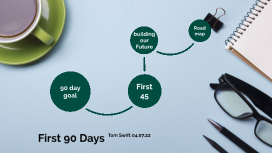
First 90 Days
Transcript: Tom Swift 04.07.22 First 90 Days 90 Day goal To have business ready proposal for initial system changes and a two year technological change road map. 90 day goal - Increase Medecator+ Sales - Improve Medecator+ functionality and user uptake - Realise new financial benefits through new technological opportunities Initiate business sign off for first system optimisation Initiate business sign off for first system optimisation To present a two year technological change road map To present a two year technological change road map Integration - First 45 days First 45 - Current Business standing and setup - AAH operations - Hospital operations - Key Stakeholders and stakeholder mapping - Current customer engagement strategy - Aligned IT and Development teams - Introduction and collaboration on current AAH IT projects - Current change process / implementations of system change Understanding current business operations Induction support Induction Key reporting lines Business overview Stakeholder introductions Weekly project governance & Check ins What changes can we make? Understand our opportunities building our Future - System Gap analysis - Current Benefits realisation model - User feedback - Business change readiness - Opportunity and associated risks - Current business risk assessment - competition offerings / comparisons - Exploration of ideas / realistic expectations of internal IT parties - Change impact assessment - Stakeholder engagement - Build initial business case for first proposal Road map - Repeat orders - Suggested orders - GPHC / MHRA updates - Product Recalls - Specials
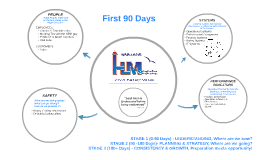
Transcript: Financial performance Operational Efficiency & Effectiveness Customer Satisfaction Growth First 90 Days Measures that tell us how the business is trending and performing in an instant EMPLOYEES Comms & Transition plan Morning Tea with the NEW guy Profile LT & Board members Visit Jobs CUSTOMERS Top 5 SYSTEMS SAFETY Enabling systems that increase effectiveness or efficiency and build value in the business PEOPLE "Right People, Right seat on the bus, Going in the Right direction" Operational Systems Performance Management Finance Systems Safety Systems IT Systems STAGE 1 (0-90 Days) - UNDERSTANDING, Where are we now? STAGE 2 (90 -180 Days)- PLANNING & STRATEGY, Where are we going? STAGE 3 (180+ Days) - CONSISTENCY & GROWTH, Preparation meets opportunity! History of safety performance Embedded safety culture Steve Covey "Seek First to Understand before being understood" What are we doing today? What can go wrong? How do we prevent it? PERFORMANCE INDICATORS
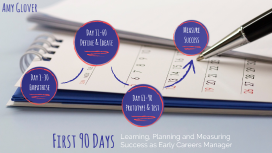
Transcript: Amy Glover Learning, Planning and Measuring Success as Early Careers Manager First 90 Days Day 1-30 Empathise Day 1-30 Empathise Understand the 'Why' BRC Mission and Goals Business Problem? Needs of Generation Z Organisational structures 'Safe, Heard and Developed' Understand the 'Why' Build Relationships Build my internal network Key partners and external contacts Secure buy-in Young Staff Network Supporting People in Crisis Build Relationships Learning - The Story So Far Review existing activity Best Practice Persona Development Skills Assessment Learning: The Story So Far Day 31 - 60 Define and Ideate Day 31-60 Define & Ideate Engagement and Co-production Facilitate workshops Co-production principles Feedback, relationships and accountability Engagement & Co-production Analyse and Prioritise Evaluation of learning so far SWOT Analysis Connect with EDI Priorities and action plan Identify Opportunities Develop Strategic Plan Programme architecture Recommended improvements Higher/further education Graduates/apprentices/staff Management support Develop Strategic plan Day 61-90 Prototype and Test Day 61-90 Prototype & Test Programme Launch Quick wins Roles, responsibilities and timelines How to deploy at scale Programme Launch Quality Assurance Performance metrics Formative evaluation Quality of delivery Quality Assurance Consolidate Relationships and Build Momentum Reporting and feedback Recognition and celebration Build Momentum Measure Success What would 'Good' look like after 90 days? Knowledge and relationships Strategic Plan and objectives Co-production Network Impact Measurement Tools Value Proposition 360-Degree Feedback Self Assessment Initial Outcomes Progress on Strategic Goals Performance Metrics Increased Engagement ...and how would you measure that? Measuring Success

first 90 days
Transcript: First 90 days Aliya Kunyazova WHY WE ARE HERE? WHY WE ARE HERE? Sponsor: Maria G Content Owner: Aliya K. Time allocated: 60 min Facilitator: Maria G. PURPOSE Purpose of the session Engage MT in the leadership journey conversation, get advice and support required. For the MT is to get visibility on the newly recruited talent progress and development OUTCOMES OUTCOMES What specific outcomes do we want? MT provided feedback/support needed, got visibility on talent What decisions are required? Support requested AS A RESULT OF THIS SESSION I WOULD LIKE YOU TO: We have a unique opportunity to grow CM expertise on the market for the next 2 years with right mindset, set up and choices! We set up our talents up to success! THINK: RESULT INSPIRED, ENERGIZED & COMMITTED TO SUPPORT! FEEL: Provide feedback and align on support requested DO: Agenda About me My journey so far My priorities for 2020 Challenges and support needed from MT AGENDA ABOUT ME IF IT DOES NOT CHALLENGE YOU IT DOES NOT CHANGE YOU! JOURNEY SO FAR WORK-LIFE BALANCE OPEN DEVELOPMENT FUN ON-BOARDING WOW ADAPTATION SUPPORT MEETINGS FEEDBACKS GLM CHALLENGE 1:1 STRESS GREAT PEOPLE PEOPLE 1. High quality PDP of direct reports 2. Synergize the team: CM weekly, CMTM monthly 3. Work load allocation among team members PEOPLE BUSINESS BUSINESS New approach to customized activities Optimized approach to CAM Structured and effective WOW process with progression Understanding of category and our performance Operational: CM GM Day, in absence of CAM KZ leading Top 2 clients in KZ from CM side, supporting Aidai in Bel. Personal Development opportunities OPPORTUNITIES FROM: New to Mars, not familiar with the policies, practices, org structures, doesn't know how things are done thru formal and informal networks. ORGANIZATIONAL AGILITY TO: 1. Understands and lives Mars culture 2. Knows how to get things done both through formal channels and the informal network 3. Understands the origin and reasoning behind key policies, practices, and procedures FROM: Has LM experience outside of Mars, but 1st year LM at Mars GLM TO: Effectively utilizes all steps of GLM. MY PURPOSE AND PRIORITIES FOR 2020 PRIORITIES 2020 WHY Customer Marketing team, Leverage growth opportunities in the channels and customers by translating category, brand, shopper and customer insights into strategies, plans, tools and capabilities that deliver excellence in activities execution HOW FROM: low functional capabilities & customer centricity TO: To a team consists of subject matter experts with customer centric mindset 1. Recruit, grow Customer Activation Managers with high learning agility, invest on functional & customer expertise 2. Build customer centric CM within Mars 3. Create strong network with Lead Market, Regional Team and Global team WHAT 1. From 2 Customer activation strategies to Customer activation strategies for all SP accounts, combining Mars & Customers strategies 2. Set up CM for long term success: knowledge management, new channels development, talent development 3. Engagement (placement of team, team spirit, wow, network with regional&global team) CHALLENGES & SUPPORT NEEDED

First 90 days
Transcript: Day to day / regular Systems Team Gaps / Efficiencies Staffing & Outputs FUTURE UNDERSTANDING Objectives Vision for finance function Annual timetable Company Performance Issues/challenges Set expectations
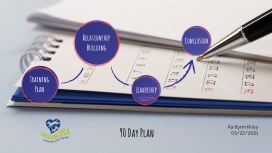
Transcript: Kaitlynn Riley 03/22/2021 90 Day Plan Training Plan One day at a time Address common issues I experienced Learning from your staff It's a two way street! Ensure coordinators are educated on vet care/animal welfare Reach out to department heads for my own training/development Training Plan Microsoft Programs OneNote or Excel Spreadsheets Easy access to information Response templates for text/email OneNote & Excel Employee Strengths/Weaknesses Employee Strengths/ Weaknesses Use to team's advantage Recognition Regular feedback Call data Daily goals/focuses Be open to new ideas Relationship Building Simply introduce myself and program Regular meetings Common issues encountered Monitor information requested on calls Relationship Building Anticipated Priorities Anticipated Priorities Scheduling Adoptions Animal surrender Food pantry Measuring Success Measuring Success Regular meetings within organization Community feedback Employee feedback Leadership Lead with positivity Be understanding Check-ins Employee growth Acknowledge team success Leadership GOAL 1 Goal 1 Stellar employee retention GOAL 2 GOAL 2 Counsel employees before something becomes problematic Conclusion Great and necessary additon to organization Must be implemented successfully to properly assist clients Conclusion

Transcript: The Road Ahead You've been offered the position... Job Offer CONGRATULATIONS! Next Steps: Confirm Availability Negotiate Pay Accept Position Title How to Negotiate Salary: Let's Talk Pay... - Many workers in WA earn Paid Sick & Safe Leave - Wage Theft is illegal - don't work off the clock, you are owed what pay you agreed to - All workers have a fair chance to apply for a job without being asked about their crimial history right away "A famous study done by Linda Babcock for her book Women Don’t Ask revealed that only about 7% of women attempted to negotiate their first salary, while 57% of men did. Of those people who negotiated, they were able to increase their salary by over 7%." Title Seattle's minium wage increases every January 501+ Employees = $16.00 500 or fewer Employees = $15.00 or $12.00 + $3.00 in tips/medical benefits Title Title Title Title Welcome to the HR Office Meet HR New Hire Paperwork I9 W2 Company Policies Other Forms New Hire Paperwork What you need: 2 forms of ID VOIDED Check/Letter from your bank Permits Pay Checks Let's talk PAY How do will I receive my paycheck? When will I get paid? ADVOCATE: Can you help me understand the deductions? BENEFITS Additional / Not all Employers: - Dental insurance - Vision insurance - Retirement benefits or accounts (401K) - Healthcare spending or reimbursement accounts, such as HSAs, FSAs, and HRAs. - Long term disability insurance Basic Full-Time Benefits: - Paid time off (PTO, sick days, and vacation days) - Health insurance - Staff Meal On-boarding "let's get situated..." On-boarding New employee on-boarding is the process of getting new hires adjusted to the social and performance aspects of their new jobs quickly and smoothly. Work Place Culture: Company culture refers to the personality of a company. Company Culture It defines the environment in which employees work. Company culture includes a variety of elements, including work environment, company mission, value, ethics, expectations, and goals. Training New Staff Training It is the process through which new hires learn the attitudes, knowledge, skills, and behaviors required to function effectively within an organization. Writer, Producer, Director & Star The first 90 days of a new job is an evaluation period Month 1 The employer is looking for you to deliver on the promises and claims you made in your interview Month 2 How quickly can you get up and running and start contributing? Can you maintain the work ethic you showed at the start? Month 3 Entering a new job, position or career can be challenging... Learning Systems Who will help you get acclimated? How are you going rise to your greatest potential? Staying Hired or Ask For Feedback Timeline Be Prepared HIRED Be On-Time Maintain Stamina Getting Fired Sleep. Eat. Take Care of Yourself. "Early is on-time, On-time is late" Ask how you can improve What pieces do you need to be successful? 90 Day Goal! 90 Days on the Job completed! so, whats next? Next Steps: Next Steps Benefits - speak to HR or managment to sign up Feedback - speak to your manager for strengths & challenges Career Development - what opportunities are available to me? what am I interested in pursuing? Reflect on your success Personal Development Challenge yourself Set healthy boundaries Speak with your mentor or Career Specialist

Transcript: Thank You! How Penicillin was discovered Penicillin Sir Alexander Fleming was studding a bacteria in culture dishes. He noticed that a mold called Penicillin was also growing in some of the dishes. A clear area existed around the mold because all the bacteria that had grown in this area had died Energy might be the most important thing in our lives. we use it for almost everything,but what is energy, energy is the strength and vitality required for sustained physical or mental activity. There are lots of types of energy some are shown in the image Energy Energy The periodic table is a table of the chemical elements arranged in order of atomic number, usually in rows, so that elements with similar atomic structure (and hence similar chemical properties) appear in vertical columns. Periodic Table Periodic Table Chemistry is the branch of science that deals with the identification of the substances of which matter is composed; the investigation of their properties and the ways in which they interact, combine, and change; and the use of these processes to form new substances. Chemistry Chemistry
Explore our templates for more presentation inspiration

World Map - Antique
Description: Impactful presentations need stunning visuals and a meaningful metaphor to show high-level concepts and the smaller details. This customizable presentation template uses a classic world map visual to help you navigate complex information while staying grounded in your presentation’s core message.

Creativity-Paint
Description: For grant requests, funding pitches, program proposals, or any other kind of education or nonprofit presentation, this Prezi template is the way to generate interest and momentum. Like all Prezi education templates and Prezi nonprofit templates, it’s easily customizable.

Lesson Plan - Board
Description: A well-organized lesson plan is the difference between getting things done and things getting out of hand. This vibrant, customizable, easy-to-use Prezi presentation template features a sticky note theme, so you'll be able to keep track of topics, assignments, exams, and more without missing a beat.

Top Lesson Plan Template for Teachers | Prezi
Description: This customizable, colorful Prezi presentation template makes creating and sharing lesson plans simple, clear, and engaging. The friendly, board game-inspired theme provides a clear path for organizing subjects, assignments, exams, and more.
Now you can make any subject more engaging and memorable
- The Science
- Conversational Presenting
- For Business
- For Education
- Testimonials
- Presentation Gallery
- Video Gallery
- Design Gallery
- Our Customers
- Company Information
- Prezi Support
- Prezi Classic Support
- Hire an Expert
- Data Visualization
- Infographics
June 28, 2024
May 31, 2024
May 24, 2024
- Latest posts
© 2024 Prezi Inc. Terms
- New Features
- Integrations
Guides & Templates
Additional resources.
- Happy Monday Club
- Newsletter Newsletter
- Bright Side Conference
- Chat with us
- Partnerships
Quickly build beautiful emails & multi-channel campaigns with our easy-to-use design tools and templates.
Sync your employee lists, segment your messages, and communicate across the channels your team uses the most.
Create streamlined processes and set permissions to manage your internal emails across a global, distributed team.
Measure the effectiveness of your internal campaigns and improve engagement across your company.
Download free, customizable internal comms resources
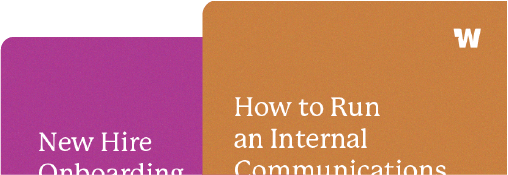
Read helpful how-to articles & quick tips

Sign up for free webinars & workshops

Learn more about our mission, vision, & values

Join a talented team of 50+ Workshoppers!

A 30/60/90 plan example for internal communications
October 16th, 2023 Jamie Bell

Here are our recommendations for a thorough 30-60-90 day plan in a new internal communications role. You can obviously use this for your first 90 days in a new job, but it’s also an amazing thing to bring to interviews and/or a really good option for a hard reset! Remember: your first 90 days are your first impressions. It’s an opportunity you may not get again, and it’s often a rare moment where you can be a bit high level before you have to dive into the day-to-day work. Use this chance wisely and structure your first few months for success!
We’ll start with an overview, and then dive into each piece into a bit more detail:
The first 30 days:
- Share your 30-60-90 day plan
- Understand the company’s current goals, priorities, & values
- Run an internal communications survey
- Start a listening tour
- Review the current toolset & processes
- Identify little wins
The first 60 days:
- Complete an internal communications audit
- Determine key metrics & set benchmarks
- Create an editorial calendar
- Set up monthly touchpoints with key stakeholders
- Achieve and showcase those little wins
The first 90 days:
- Document your internal communications strategy
- Publish a monthly report
- Evaluate new tools
- Advocate for resources (budget, team, etc.)
- Launch or revamp a few core internal communication campaigns
You can download an interactive and editable checklist for your 30/60/90-day internal communications plan here!
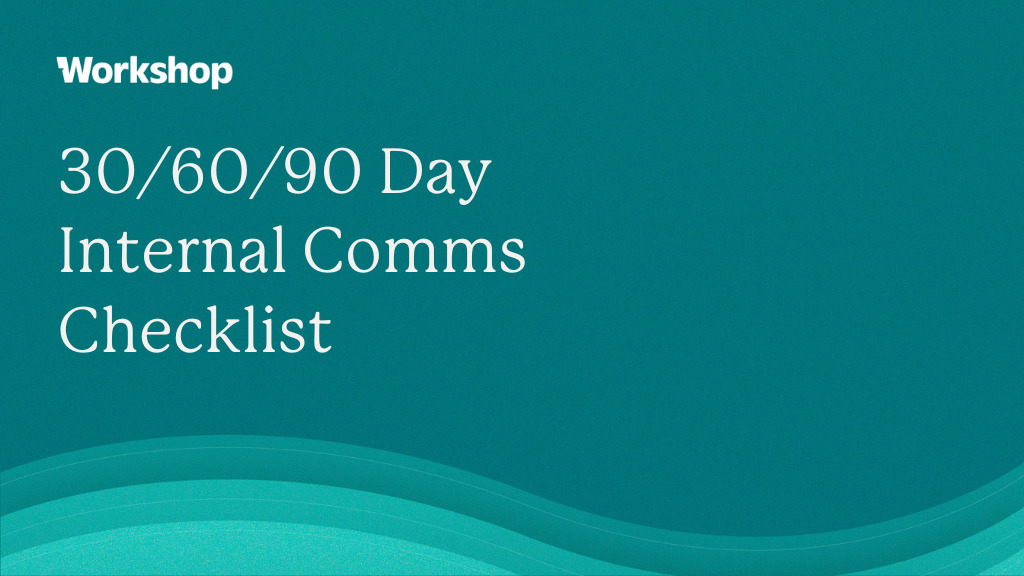
The first 30 days
In your first month of a new role, your number one goal is really just to listen and learn. You aren’t trying to implement a bunch of playbooks or processes…really, it’s about getting to know your colleagues, your company, and really just get a general lay of the land.
1.) Share your 30/60/90 day plan
This may seem a bit self-explanatory, but it’s a seriously valuable (and impressive) step! Simply share this plan with your boss and key stakeholders to help them understand what they can expect from you in the first few months of the role. It’s a really quick way to actually implement your own “internal communications” and ensure that everybody is on the same page.
2.) Understand the company’s current goals, priorities, & values
You play a crucial role in helping employees understand and align with company goals, priorities, and values. Take this first month to really dive into the organization’s mission and values, and demonstrate a real commitment to the company’s mission. Ask questions about the company’s priorities, and align your communication strategy accordingly. This way, you’re positioning yourself as a strategic partner right from the beginning.
3. ) Run an internal communications survey
Let’s get some quantitative data straight out of the gate! Sending out an internal comms survey is also a great way to get a view on what is or isn’t working in the company’s current internal comms strategy. This will give you a good benchmark to start with and a way to measure your efforts over time.
We recommend asking a mix of scaling and open-ended questions, such as:
- How happy are you with the overall internal communication you currently receive?
- What information do you wish you had more of?
- What information do you wish you had less of?
We have an internal communications survey template you can download here!
4.) start a listening tour.
This is a great time to begin a few qualitative interviews, as well. You’re looking to audit the current state of internal communications and really get a sense of the baseline. (I often structure these as a start/stop/continue).
A few things to keep in mind:
- Choose a diverse audience! Select employees from different departments, roles, locations, with different levels of seniority, tenure, backgrounds, etc.
- Include key stakeholders 😉
- Use 1-on-1 interviews or small focus groups (8-10)
- Prepare open-ended questions to guide the discussions
Make sure you’re doing informal listening, as well (basically, lurking)! Be everywhere your employees are and just listen . In the office, try to keep out for those “watercooler”-type conversations. When evaluating pre-existing communication channels, look for the most and least popular posts and see if you can determine trends or patterns. And be sure to find out if there are private channels or other channels that employees are using to communicate!
5.) Review the current toolset & processes
Create a list of all the internal communication tools and platforms currently in use. Evaluate each tool’s purpose, functionality, and user adoption.
A few other things you’re looking for:
- What are the pain points with the current tools?
- Is there training and documentation on these tools?
- What department owns the tool? And/or budget?
- Where do communication requests come from?
- Are your internal communications proactive or reactive?
- Do you have easy ways to collect feedback?
6.) Identify little wins
Look for ways to make a quick impact with as few resources as possible (time, money, energy, etc.)
A few of our favorites to recommend:
- Implement Q&A at all-hands meetings
- Add merge tags to internal emails & don’t send them from a “catchall”
- Send a welcome email introducing yourself to the team
- Create a mini-campaign to highlight a recent win that you weren’t a part of
- Create a communications request form and/or streamline requests
The first 60 days
1. ) complete an internal communications audit.
We know this can seem like an overwhelming task! Typically, we break down an internal communication audit into seven key steps. (You can find our complete guide here! It will walk you through how to run an audit from start to finish.)
Luckily, you’ve already done a TON of the work in your first 30 days, and a lot of what you need to do now is just review all of your data, put together an action plan, publish a report, and share your insights. This is an incredible way to get the buy-in you need from senior leadership, as well!
Here are a few common areas to focus your audit and action plan:
- Channel effectiveness
- Communication preferences
- Cross-department communication
- Approval process
- Executive communication
- Employee awareness and recall
- Resource availability and bottlenecks
2. ) Determine key metrics & set benchmarks
We always start our initial focus on email because everyone has it in one way or another. It’s consistently ranked the #1 channel for internal comms, in many times regardless of generation or industry.
Whether or not you have access to these metrics is based on your tools, but here is a good overview:
- Email : Open rate, click-through rate, mobile usage, time read, metrics by department/role/location, survey data, campaign analytics (Want all of these metrics? Take a look at Workshop’s internal email platform !)
- Intranet : Login numbers, usage time, traffic, clicks, top posts, most-commented posts
- Slack: Weekly active messages, how many messages were read in public channels, private channels, and direct messages; active members, change in active members
- SMS : Opens, clicks
- Zoom/video : Attendance
- 1-on-1s : Frequency, attendance
Our advice for all internal communications metrics (and marketing metrics, and engagement metrics, and really any metrics for that matter) is this: benchmark against yourself.
By this, we mean that you should make sure you are setting your own benchmark, and not necessarily using industry standards/Googling for an average open rate for internal communications. There are many reasons for this, but for starters, you don’t want to set an unrealistic goal for yourself. If your organization has an internal email open rate of 30%, it’s not going to be feasible for you to try to hit 70-80% (which is the average open rate we see across our 200+ customers). And open rates can vary widely across industries, employee sizes, locations, etc., and you could be chasing a metric that you may not realistically reach.
3.) Create an editorial calendar
This is one that won’t take a ton of time to put together, but it’s a fantastic deliverable and it will save you hours and hours of stress in the future. Rather than spending time every single month researching holidays, observances, and other event dates, put together your internal communications editorial calendar now. (Be sure to check with the company, too, to discover if they have their own internal events or key deadlines — like open enrollment, holiday parties, the company anniversary, etc.)
We actually have an internal communications editorial calendar that you can use as a template. This calendar will help stay on top of important deadlines, ensure consistency in your messaging, and make the most of your time. We’ve also pre-filled it with common holidays and observances to give you a great head start!
4.) Set up monthly touchpoints with key stakeholders
Meeting with key stakeholders is a proactive and strategic approach that enhances the effectiveness of yourinternal communication efforts, fosters collaboration, and makes sure everyone is on the same page. Whether it’s quarterly, monthly, or bi-weekly, make sure you have the following departments on your side early: HR, IT, marketing, and the leadership team.
5.) Achieve and showcase those little wins
Now is the time to execute on all of the little wins you identified last month! Launch those small initiatives, and then create a “smile file” to keep screenshots of DMs or email replies that are praising those efforts or just saying nice things. Be sure to share those with leadership or in public channels to celebrate!
The first 90 days
1.) document your internal communications strategy.
It’s time to create a comprehensive internal communication strategy document! You’ve done all the work for this, and now you get to put all of your research together and feel REALLY good about the future of your department. Start by defining clear goals that you can directly achieve (we have a list of common KPIs to choose from here)! Then, build out a multi-channel strategy that’s designed to reach 100% of your employees. Finally, make sure that your campaigns and major efforts are incorporating everything that you’ve learned from the survey, audit, listening tour, etc.
- Define clear goals using metrics that you can directly achieve.
- Create a multi-channel strategy designed to reach 100% of your employees.
- Incorporate everything that you’ve learned from the survey, audit, listening tour, etc.
2.) Publish a monthly report
Tracking metrics helps the leadership team understand the value and impact of your internal communications initiatives and efforts.
Generating a monthly report is a great way to help compile your internal comms efforts, successes, opportunities, and key metrics so you can present a nicely organized report (and showcase the value of your internal comms efforts!) to key stakeholders and leadership.
Things we like to include:
- A summary of your overall performance
- Quick details about how the team is performing on its current goals
- Sharing 3-4 of your best performing emails or intranet posts — your slam dunks!
- A story about your gold medal winner for the month – your highest performing internal communications of the month
- A table that showcases your KPIs (For example, if your KPI is Internal Emails Sent, list out the target versus what was actually sent)
- And a section that details your opportunities — something the team is focusing on for the next month!
Here’s a template for an internal communications report!
3.) Evaluate new tools
Make sure that you have the tools you need to create, send, manage, and measure the internal communications strategy you’ve outlined. At a minimum, there are four tools that we recommend as a part of every internal communications tech stack.
- Email = primary method
- Text = great for frontline / desk-less employees
- Intranet = archival / asynchronous
- Slack/Teams = mobile-first generation
We dive into all four of these options in-depth in this article . Also, make sure your tools evolve! They should suit YOUR workflow and be able to deliver on the needs of YOUR audience. They should be tools that are improving over time, and not archaic software that needs a bunch of internal support to keep maintained.
4.) Advocate for resources
This is your time to make the big asks for the budget and resources you need! You’ve been building buy-in and you’ve laid out an incredibly compelling strategy. So be sure that your budget is set up to support that in a really reasonable way that’s fully aligned with the business goals. Your budget should encompass program costs, new hires, and the necessary toolset.
You can also explore unconventional approaches, such as requesting a portion of the marketing budget for internal marketing. You could also help the team audit existing spending and reallocate funds strategically to align with your goals!
5.) Launch or revamp a few core internal communication campaigns
Spice up a few old campaigns (or launch new ones)! We recommend the following because they’re the most impactful:
- A monthly newsletter
- An all-hands meeting recap
- A weekly CEO email
These tend to be the most “expensive” emails (in theory) because they go out to the entire organization. If these don’t fit, simply prioritize 1-3 emails that are sent to the entire staff list.
The only 4 internal communications tools you need
If you’re getting settled in your new role, one of the first places to look is at your internal communications tech stack. Here are the only four internal communications tools you need in 2024!
Join the Happy Monday Club!
Start your week inspired and energized with our practical newsletter about positive company culture! It features actionable articles and little surprises, sent every Monday morning.
🎉 You're in!

We're building a new, vibrant, and modern intranet
Join our waitlist to be the first to learn when it's available!
Got it, thanks!
Get a demo of workshop.
Get a live demo & your questions answered with one of our product experts.

We'll also make sure you leave with:
- Suggestions for getting the most out of your existing communications channels
- Best practices we've learned from extensive research
- A customized solution, aligned to your company goals
- A free t-shirt, if you mention this message ;)
More From Forbes
How to ace your new job in the first 90 days.
- Share to Facebook
- Share to Twitter
- Share to Linkedin
By Jane Bianchi
This post originally appeared on LearnVest .
As the saying goes, change is the only constant in life—and in your career too. (Well, we added the last part.)
But the truth is that you may experience all sorts of workplace change when you get a promotion, land a new gig at a different company, and even when your own organization downsizes or merges with another one.
“I view all of those as transitions,” says Michael D. Watkins, co-founder of leadership development company Genesis Advisers and author of “ The First 90 Days: Proven Strategies for Getting Up to Speed Faster and Smarter .”
And when you’re in transition, your role is likely to shift too—whether it means tackling new job responsibilities, working in a different environment or reporting to a new boss. Sometimes it can even be all of the above!
Regardless of your particular situation, it’s a crucial time. In fact, Watkins argues that impressing your manager and colleagues within the first 90 days is not only essential to your success in your current role but also for your overall career.
No pressure, right?
Fortunately, it’s not as difficult as it sounds—if you know how to make the right impression by following these tips from Watkins.
LearnVest: Why are the first 90 days on the job so important?
Michael D. Watkins: Lots of my research shows that what you do early on during a job transition is what matters most. Your colleagues and your boss form opinions about you based on limited information, and those opinions are sticky—it’s hard to change their minds. So shape their impressions of you to the best of your ability.
Why 90 days, specifically? It’s a quarter, which is a recognized time frame in the business world. Companies often track how they’re doing based on how much progress they make each quarter—and you should too.
RELATED: 8 Ultimate Opening Lines for Fearless Networking
What’s a key way to make a good impression from the get-go?
I see people focus too much on the technical job skills and not enough on the company’s politics. Build key relationships early. Ask your boss, “Who is it critical that I get to know?” And then invite those people to coffee or lunch and pick their brains. Don’t just focus “vertically” on managers above you—also create “horizontal” alliances with colleagues. You want to have support at all levels.
You’ve mentioned that people can quickly fall into vicious cycles if they’re not careful. What does that mean—and how does it happen?
Once the die is cast in one direction or the other, it tends to be self-perpetuating—and it can turn into a negative feedback loop if you’re not careful. For example, if you make early mistakes, people will look at you as ineffective going forward because they’ll be looking at you through a darkened lens. If you’re late your first week, you may be seen as lazy or irresponsible—and that reputation can be tough to shake. And if you make a bad call and the company loses money, your judgment may be called into question when it comes to future decisions.
RELATED: 5 Career Mistakes You Didn’t Know You Were Making
Given that there’s usually a learning curve during a transition, how can you be extra careful to prevent mistakes?
Take time to observe the office culture, and try your best to blend in. And always listen before you speak. Sometimes people feel a need to prove themselves early on, so they form an opinion before they really know what they’re talking about.
Also, don’t talk about the last company you were at or put awards that you won at your previous employer on your office wall. Nobody wants to hear or see that, especially if your old company is considered a competitor.
Lastly, follow up. If you promise someone something, make sure you deliver what you said you would on time. That builds trust.
Is there a way to speed up the learning process?
Throw work-life balance out the window for a little while. There’s no substitute for logging the time and digging in. This can be especially challenging if you have a family, so see if your spouse or a grandparent can help out more during this time. Or perhaps you can hire someone to help temporarily with child care.
Also seek a mentor. Is there someone at the company who has done what you’re doing before? Enlist that person’s help and offer help in return. For instance, maybe a colleague can show you how to master the internal computer system and, in return, you can teach that person how to craft an effective tweet. Every networking relationship is an exchange.
You’ve talked about assessing your vulnerabilities within the first 90 days. Why is this important?
There’s always a risk you’ll gravitate toward the parts of the job that you enjoy and feel you’re good at—and ignore the parts of the job that you dislike or aren’t as good at. It’s like a right-handed person who favors her right arm—the muscles in her right arm will grow, but the muscles in her left arm won’t. Try to become more ambidextrous, so to speak, so you’re well-rounded.
The first step is to identify your strengths and weaknesses, so make a list. The second step is to force yourself to prioritize job responsibilities in terms of importance, rather than preference. For example, maybe you love giving presentations, but you hate building spreadsheet models. Yet building spreadsheet models is what’s likely to get you a promotion. The concern is that you’ll schedule too many presentations and either put off or outsource building spreadsheet models.
This strategy won’t help you become more well-rounded or get ahead, so create a rule that you can’t schedule a presentation until you’ve spent a certain number of hours building spreadsheet models. By forcing yourself to do this, you might become faster at it and perhaps even learn to enjoy it.
What can you do to make your boss like, respect and trust you from the start?
Be proactive because it’s your responsibility to make the relationship work. If your boss doesn’t reach out much, you make it a point to check in regularly. Ask how your boss prefers to be contacted—in person, via phone, by email—and how often.
And manage expectations—bosses don’t like surprises. If something is taking a turn for the worse, let your boss know there’s a problem and have a plan for how to solve it. These strategies will help your boss get up to speed and realize you’re reliable.
What are some common pitfalls when dealing with a new boss?
Some people try to change their boss, and that doesn’t work. You need to get accustomed to your manager’s style and idiosyncrasies. Maybe, for instance, your boss loves meetings and you don’t. If you follow her lead and schedule them, you’re more likely to please her.
It’s also crucial to do work that matters to your boss. Even if you wouldn’t prioritize in the same way, you should prioritize the way your boss does in the first 90 days.
Of course, if your boss asks you to do something unethical or illegal, then you may feel the need to push back immediately. But if you disagree about something less fundamental, like how often to communicate, wait to tactfully bring up your concern after the first 90 days.
Say: “I’ve been checking in with you daily. It feels to me like we’re doing well together. Do you still think it’s necessary to check in daily, or can we go to a weekly check-in?” When you present it in the form of a question, you’re still respecting your boss’s authority and leaving the decision up to your boss.
RELATED: 8 Get-Ahead Questions to Ask Your Boss
Why is it crucial to be flexible and adaptable in a new role?
As you move up, recognize that the skills that helped you excel at your last job won’t necessarily make you successful in your current role. Say a great salesperson becomes a manager. Maybe this person can persuade customers to buy products—but doesn’t know what to do when employees come in late or don’t meet quotas.
Recognize what new skills your new job requires—and grow into the position. Some skills will come naturally to you as you spend more time on new tasks, but you may require extra help for others. See if there are any free online programs or books you can read that would boost your knowledge. Then talk to your human resources manager to see if the company offers internal programs or discounts on outside conferences or classes that might accelerate your learning.
In your book, you talk about securing an “early win.” What does that mean?
Build credibility for yourself by being seen as someone who is learning and connecting with the organization. So if, say, one of your products is struggling, perhaps your “early win” is to push through a decision to either kill it or devote more resources to it and pump up sales. Or perhaps you hire a new manager or arrange an event that boosts morale to quickly turn things around.
I worked with a guy in the pharmaceutical industry who was tapped to run a $2 billion company. He decided that he would take 30 days to talk with people in the company before he even started his job. He spoke to everyone—senior people, junior people, support people.
And when Day One finally came, everyone felt like he’d already been there. They admired his passion, curiosity and sincerity, and after 90 days, he was seen as being on top of the business.
- Editorial Standards
- Reprints & Permissions

- What Is TAB
- Advisory Boards
- Business Coaching
- StratPro Leadership Transformation Program
- Strategic Leadership Tools
- Our Members
- Case Studies
- White Papers
- Business Diagnostic

The Alternative Board Blog
A guide for ceos —11 ways to make an impact in your first 90 days.

Your first 90 days as CEO will set the tone for your entire tenure in the organization. Therefore, this is a crucial time, and the goal is to establish your credibility and trust, so the team and the shareholders have confidence in you moving forward
#1 Learn, engage, communicate.
If you have walked into the role in good times, here's how you should approach your first 90 days. In a crisis, these steps still apply but need to be implemented in days or weeks, not months.
- Learn everything about the business: the financials, the products/services, the people, and the customers.
- Engage with your leaders as soon as possible. Listen. Get your finger on the pulse of the company and keep it there.
- Communicate to the entire team, live if possible. Introduce yourself, share what you are working on, and when you'll have more to share.
- Meet all employees individually or in small groups. Listen, learn, and encourage.
- Work with your leaders to develop or amend plans, get board /owner approval as needed.
- Communicate the overall plan yourself, have leaders communicate details to their teams.
- Execute and deliver.
Mark Stockhowe, Owner at TAB Greater Minneapolis-St. Paul Area
#2. Observe, listen, and learn.
Many CEOs want to jump right in and get their feet wet to take action right away, but it's best to take it slower in many instances. Take 3-6 months and meet with as many people as you can and ask a lot of questions and listen. Your team and your employees will tell you a lot if you ask the right questions, truly listen to what they have to say, and be receptive to the feedback. Based on this feedback, learn the business's key challenges and develop a plan to address them. I promise you that if you create an action plan based on insights you learned from your team, your team will appreciate that you were listening, and they will value your leadership style.
John Mousseau, Owner at TAB Jersey Shore North
#3. Here are 5 Things A Newly Appointed CEO Should Do in Their First 90 Days.
A newly appointed CEO should come into this position with a clear understanding of the short-to long-term mandate, e.g., growth, turnaround, and culture.
Want additional insight? Read 5 Ways Business Owners and CEOs Prepare to Seize Opportunities now to learn more

- Introductions and Garnering Information: As an incoming CEO, meetings should be arranged to introduce themselves personally and professionally, highlighting vision and critical mandates. From here, essential listening is crucial to learn about the company and its culture. Meetings should be held first with direct reports at the Executive level, followed by next-tier Executives and Department Heads. Assemblies should follow these meetings with large groups of employees in a town hall format where possible. Identification of key influencers at all levels and getting to know them is highly recommended.
- Deep Discovery: From the introductory meetings, more detailed discussions should be arranged with smaller groups of each of the following: direct reports and other executives, department heads, along with influencers, to get a deeper understanding of some of the vital information garnered in the introductory meetings.
- Evaluation: Review mandate and draft strategies against insights from meetings. Revise strategy as necessary, frame actions with defined priorities and deliverables in timeline buckets. Identification of a few challenges or opportunities for quick, small wins helps build momentum, confidence, and acceptance.
- Refinement: Discuss new draft plans with the key stakeholders for feedback and buy-in. Finalize plans with KPIs along with a monitoring/evaluation type framework.
- Approval: Meet with the Board for agreement and sign-off at the end of the first 90-day period.
Angeline Gillings, CEO at TAB Miami West
#4. Start at the cash flow.
What a CEO should do when first appointed depends on the company and their situation, but, in most cases, the first place to go is the cash flow. Ensure that the company runs an aging analysis on receivables and payables and put in a DSO calculation for receivables. Cash is the lifeblood of a company, and if you don't have that, you don't have much else.
Steve Davies, CEO at TAB Nassau
#5. First diagnose, then act.
Start with a diagnosis by using DISC assessments to understand the personality and motivators of the management team. Meet them one-to-one and learn about their vision.
Attend the operational and strategic management meetings to learn about the content, process, and the participants' behaviors.
Review the goals and the strategic plan with the management team. Work on their alignment.
Focus on execution and accountability.
Alfredo Puche, Director at TAB Nelson Marlborough, New Zealand
#6. Make a great first impression — and establish your leadership style.
The new CEO's first 90 days is a honeymoon period where she will be feted and indulged and tested. During this period, the CEO should make a favorable impression and instill confidence while she identifies challenges, determines her key objectives, and drafts a timetable. When the CEO makes known her values and demonstrates her leadership style, everyone in the organization knows what to expect.
Joe Farach, CEO TAB Georgia Northeast
#7. Build trust and learn.
As a new CEO, the first 90 days are the most critical for building trust and understanding what is "really" going on in the organization, not just what people want you to know. You will be stepping into an environment where people are worried that you will replace them with people you trust. They may already be interviewing in other companies.
Here are ten steps to get you started on the right foot:
- Listen, Listen, Listen –Meet with each department's leader and earn their trust in you. Find out what they would do to run the organization better. Write down their ideas and do your best not to advise, re-direct, judge, etc. Just listen.
- Listen more –talk to as many people who report to your leaders to see what is going well and what needs improvement.
- Review goals- Review and understand the long-term and short-term goals, strategy, and plan.
- Review past financials - Review and understand the past financials (for instance, 12 months before the pandemic), current year, and the rolling forecast.
- Review the talent- Review talent and understand the gaps.
- Review marketing and sales -Review the marketing and sales history.
- Review the SWOT- Review the organization's strengths, weaknesses, opportunities, and threats.
- Jot down ideas -Write down all the ideas your leaders and others gave you.
- Share findings with the team - At 60-90 days, bring your team together and show them what you have uncovered and their ideas for improvement, risks, etc. Ask them what approach is the best option. Buy-in is key.
- Create an updated plan -Put the updated plan into action, frequently meet to review progress, and adjust as needed.
Kim Seale, CEO at TAB Indy West
#8. Gather information from multiple perspectives and levels.
Where can we make improvements, and what would you do if you were able?
I worked for a $2B firm that had just filed Chapter 11 when the new CEO flew to see some customers and spent an hour with me on the above two questions.
Your dictating versus collaborating depends on how severe the problems are.
Bob Dodge, Owner at TAB Denver West
#9. Do absolutely nothing.
That might sound a little extreme. What it really means is this:
- Do not make any big decisions
- Do not make any sweeping changes
As a newly appointed CEO, you are qualified and competent for your job. You understand the business you are about to be running. You likely understand the product, the customers, the market, the operations, the company's systems, processes, finances, etc. These are sometimes referred to as the "hard" pillars of management.
What you may not yet have a complete grasp of is the "soft" pillars. As you might guess, these are all people-related —relationships, feelings, sentiments. Maybe you've been with this company for decades and think you know everyone well. However, they have never known you as "the boss," and you've never known them as your subordinates. Your new position, role, and title change everything.
Spend your first 90 days talking to everyone in the company. Ask questions, don't pontificate. Look at the company with fresh eyes from a new perspective. Learn. Being the new CEO does NOT make you the most competent person in the room.
On the contrary, it makes you the person in the room with the most to learn from everyone else. Save your ideas, opinions, and perspectives for your journal each night, which will come in handy later when it's time to re-engage your team on the challenges the company truly needs to resolve. If done well, you will have a united leadership team attacking the mutually agreed upon challenges. You did your leadership job in the first 90 days; now, you only need to get out of their way!
The people will make or break your tenure as CEO — and that is guaranteed. These "soft" pillars of management deserve every minute of your first 90 days!
Joe Palmer, Owner at TAB North Texas
#10 Follow my seven-step process for a new CEO's first 90 days.
Step 1: Clarify the mandate and build trust.
-Meet with the Chairman of the Board and verify the mandate as well as limits of authority.
-Start building a trust relationship and tap into the knowledge available.
-Communicate regularly to ensure you are playing within the rules of the engagement.
Step 2: Connect with, evaluate the team and clarify the way of working.
-Speak to your senior management/executive team. Ask the question: "What are the most important things you would have done if you had been appointed in this position?"
-Start the evaluation process and use a formal personal assessment tool to help you understand your colleague. This team will more than likely determine your success.
-Lay down the rules of how you work and what will be expected of them. Communicate well and make sure there are no hidden agendas.
Step 3: Gain a complete understanding of the companies product offering and key partners.
-Verify the company's competitive advantages and identify potential new ones.
-Engage with all key partners (customers, suppliers, and other service providers) and get their view on the current status/performance of the business and how the relationships can be improved.
Step 4: Go for short-term wins and celebrate success.
-Identify low-hanging fruit and vigorously drive implementation of plans to achieve this.
-Gain as much forward momentum in the first 90 days.
-Celebrate success and make sure everybody knows about it.
Step 5: Formulate the plan and arrange a launch event to unveil it.
-Do not go public until you are clear about the plan
-With all the information gathered and soundboard your thinking throughout, formulate the critical success factors, goals, and strategies to achieve success.
-Present the plan to the Board, and once approval has been obtained, arrange a launch event to share it with the business.
-Use every opportunity to repeat this and answer all questions to ensure everybody is on the same page.
Step 6: Back up the plan with processes, systems, and people.
-Structure does not follow strategy. The process does, and systems do.
-Once process and systems have been agreed upon, make sure the right people are in place.
Step 7: Implement and make adjustments and celebrate success.
-Ensure there is a formal process in place to monitor and ensure effective execution.
-Respond quickly to new information and allow for adjustments if needed. -Be quick and communicate well.
-Celebrate success and reward people who go the extra mile.
Eduan Steynberg, Owner at TAB South Africa
#11. A newly appointed CEO should do the three things in their first 90 days: be a leader, prioritize, and find trusted advisors.
The first 90 days will set the tone for your tenure as CEO. So start with the legacy you want for yourself in mind and make these three things happen:
- Be a leader: First impressions make a difference, so use them to your advantage. Be transparent about your intentions and the characteristics you value in people. Share your vision for the business in a way that gets the team excited about the future.
- Choose your priorities: Tap the full potential of the organization early. Get them all moving in the same direction toward an initiative that will make a difference for the business.
- Find trusted advisors: It will be lonely at the top. And you are going to need people you can go to for help with tough decisions. These folks may not be direct reports, and chances are they may not even work at your company or in your industry. Look for thought partners who also hold you accountable, people who are only looking after your best interest.
Ted Simpson, Owner at TAB Central New Jersey

Read our 19 Reasons You Need a Business Owner Advisory Board

Written by The Alternative Board
Related posts, unlearning conformity: how to overhaul old business paradigms, top 3 strategic musts for the coming year, 5 “must-have” elements of a strategic plan, what does the future of remote work look like, tips on future-proofing your business, what can predictive analytics do for your business, subscribe to our blog.
- Sales and marketing (140)
- Strategic Planning (135)
- Business operations (128)
- People management (69)
- Time Management (52)
- tabboards (39)
- Technology (38)
- Customer Service (37)
- Entrepreneurship (35)
- company culture (27)
- Business Coaching and Peer Boards (24)
- Money management (24)
- businessleadership (23)
- employee retention (23)
- Work life balance (22)
- Family business (17)
- leadership (15)
- business strategy (14)
- communication (12)
- human resources (12)
- employee engagement (11)
- employment (11)
- strategy (8)
- innovation (7)
- productivity (7)
- remote teams (7)
- adaptability (6)
- businesscoaching (6)
- cybersecurity (6)
- professional development (6)
- salesstrategy (6)
- strategic planning (6)
- businessethics (5)
- leadership styles (5)
- marketing (5)
- peeradvisoryboards (5)
- branding (4)
- employeedevelopment (4)
- hiring practices (4)
- socialmedia (4)
- supplychain (4)
- Mentorship (3)
- business vision (3)
- collaboration (3)
- culture (3)
- environment (3)
- future proof (3)
- networking (3)
- newnormal (3)
- remote work (3)
- sustainability (3)
- work from home (3)
- worklifebalance (3)
- workplacewellness (3)
- Planning (2)
- ecofriendly (2)
- globalization (2)
- recession management (2)
- salescycle (2)
- salesprocess (2)
- #contentisking (1)
- #customerloyalty (1)
- accountability partners (1)
- artificial intelligence (1)
- blindspots (1)
- building trust (1)
- business owner (1)
- businesstrends (1)
- customer appreciation (1)
- customerengagement (1)
- data analysis (1)
- digitalpersona (1)
- financials (1)
- globaleconomy (1)
- greenmarketing (1)
- greenwashing (1)
- onlinepresence (1)
- post-covid (1)
- risk management (1)
- riskassessment (1)
- social media (1)
- talent optimization (1)
- team building (1)
- transparency (1)

Do you want additional insight?
Download our 19 Reasons Why You Need a Business Advisory Board Now!

TAB helps forward-thinking business owners grow their businesses, increase profitability and improve their lives by leveraging local business advisory boards, private business coaching and proprietary strategic services.
Quick Links
- Find a Local Board
- My TAB Login
keep in touch
- Privacy Policy
- Terms & Conditions

COMMENTS
Preparing your first 90 days in a new job presentation can be easy and straightforward, especially when you understand that your potential employer wants to know what skills you have. You can prove to them that hiring you is a good decision. Below are the steps for preparing your first 90 days presentation: 1. Begin your research early.
Table of Contents. Writing a 'First 90 days in the job' presentation doesn't have to be daunting, follow our guide and create a presentation that gets you the job of your dreams. That's why it's important, here's how to write one: Start researching in your first interview. Focus on your potential employer's needs. Add your ...
5. Scorecard. An essential part of any 90-day plan is building a report out. As you put your thoughts to paper, be sure to include the summary of actions, progress, and updates your manager will see each week. Design your report out in an easy to follow summary you can update each week. Think of it as a mini billboard of your accomplishments.
Evaluate your presentation and delivery skills. Narrow down the candidate pool from roughly three candidates to the person who will receive the offer. Creating a 90-day presentation that will land you that job offer is not easy; it takes time and should demonstrate why you are THE person for the role. Keep this in mind, and you will ROCK this ...
Step 2. Establish your priorities. If needed, update the business priorities in your 90-day plan. Following your conversation with your manager, be sure to include any additional priorities you might now have to enable you to stay in line with your three-month plan and meet any development needs identified. Step 3.
Then, as day one in your new role draws near, make sure you have everything you need to succeed by following HBS Career Coach Matt Spielman's five steps to success on the job in the first 90 days. Why the First 90 Days Matters. In his work educating companies about successful onboarding, Spielman notes the importance of the first 90 days for ...
A 30-60-90 day plan is what it sounds like: a document that articulates your intentions for the first 30, 60, and 90 days of a new job. It lists your high-level priorities and actionable goals, as well as the metrics you'll use to measure success in those first three months. Done well, it will help you make a positive first impression on your ...
A 90-day plan is a strategic roadmap that outlines your goals, priorities, and actions for the first three months in a new role or project. By having a clear plan in place, you'll be able to hit the ground running, make a positive impact, and avoid becoming a part of that harrowing statistic. ... Template 3: 90-Day Marketing Plan PPT Slide .
Free 30 60 90 Day Plan PowerPoint Template is a 3-slide presentation for planning presentations. You can utilize slides of 30, 60, and 90 days planning to visualize goals and set realistic deadlines. Together, you can present a strategy for success in the first 90 days on job or a new project. Use This Template.
Get tips on asking the right questions, maximizing your time and effort, and building out a 90-day plan with targets and key goals that define what success means for your new role. Learn about ...
As you start a new job or take on a significant promotion, implementing a 30/60/90-day transition plan will help organize and optimize your first 90 days in the role. You have likely spent weeks ...
A 30-60-90 day plan is a document used to set goals and strategize your first three months in a new job. 30-60-90 day plans help maximize work output in the first 90 days in a new position by creating specific, manageable goals tied to the company's mission and the role's duties and expectations. Companies typically create 30-60-90-day plans ...
Develop an idea, procedure or initiative to lead and pitch it to my manager by day 90. Metric: Idea pitched. Perform tasks at a higher level by generating more sales/income/press coverage by day 80. Metric: Personal targets met. Arrange a meeting with my manager to evaluate my first three months and decide the next steps together by day 90.
The Survivor's Guide for Success at Your New Job. The First 90 Days is basically a survivor's guide for leaders in how to hit the ground running when they start a new job. Rather than "sink or swim", it's a systematic way to survive and thrive in your new role. The beauty is, The First 90 Days really helps you thrive on the job ...
4. Actively Seek Feedback. In my opinion, a new employee should actively seek feedback in the first 90 days. This shows a commitment to self-improvement and adaptability, which is essential for ...
A 90-day plan should define the specific details that will allow the new employee to achieve success. A well-written plan should spell out how this person's new role and day-to-day duties level up to company metrics and long-term plans. It should help them define priorities and checkpoints for follow-ups on their progress.
Here are 4 tips on creating your outstanding 30-60-90 day presentation: 1. Identify the key factors. Before you create a 30-60-90 day presentation, you should think of the key factors involved in it. Below are the key factors: The company and its people. The processes or procedures. The products or services they offer.
Especially focus on this principle in days 31-60. Authenticity: Be self-aware and consistent. Collaborate with others. We coach clients to emphasize this principle in Days 1-30 and 61-90 ...
Tell your story with Prezis First 90 Days In A New Job Presentation Template. Easily drag and drop images and videos and create stunning presentations. Get started. Pricing Contact sales ... Tom Swift 04.07.22 First 90 Days 90 Day goal To have business ready proposal for initial system changes and a two year technological change road map. 90 ...
2. Get Curious. One thing to do in the first 90 days is to commit to curiosity. Sounds simple, but the ego is a powerful thing. Many managers come into a role and want to show their value by doing ...
The first 30 days. In your first month of a new role, your number one goal is really just to listen and learn. You aren't trying to implement a bunch of playbooks or processes…really, it's about getting to know your colleagues, your company, and really just get a general lay of the land. 1.) Share your 30/60/90 day plan
Try to become more ambidextrous, so to speak, so you're well-rounded. The first step is to identify your strengths and weaknesses, so make a list. The second step is to force yourself to ...
A newly appointed CEO should do the three things in their first 90 days: be a leader, prioritize, and find trusted advisors. The first 90 days will set the tone for your tenure as CEO. So start with the legacy you want for yourself in mind and make these three things happen: Be a leader: First impressions make a difference, so use them to your ...
Trump downplayed his role in the Jan. 6 attack on the U.S. Capitol during the first presidential debate tonight, saying some people "asked me to go make a speech," minimizing his involvement ...